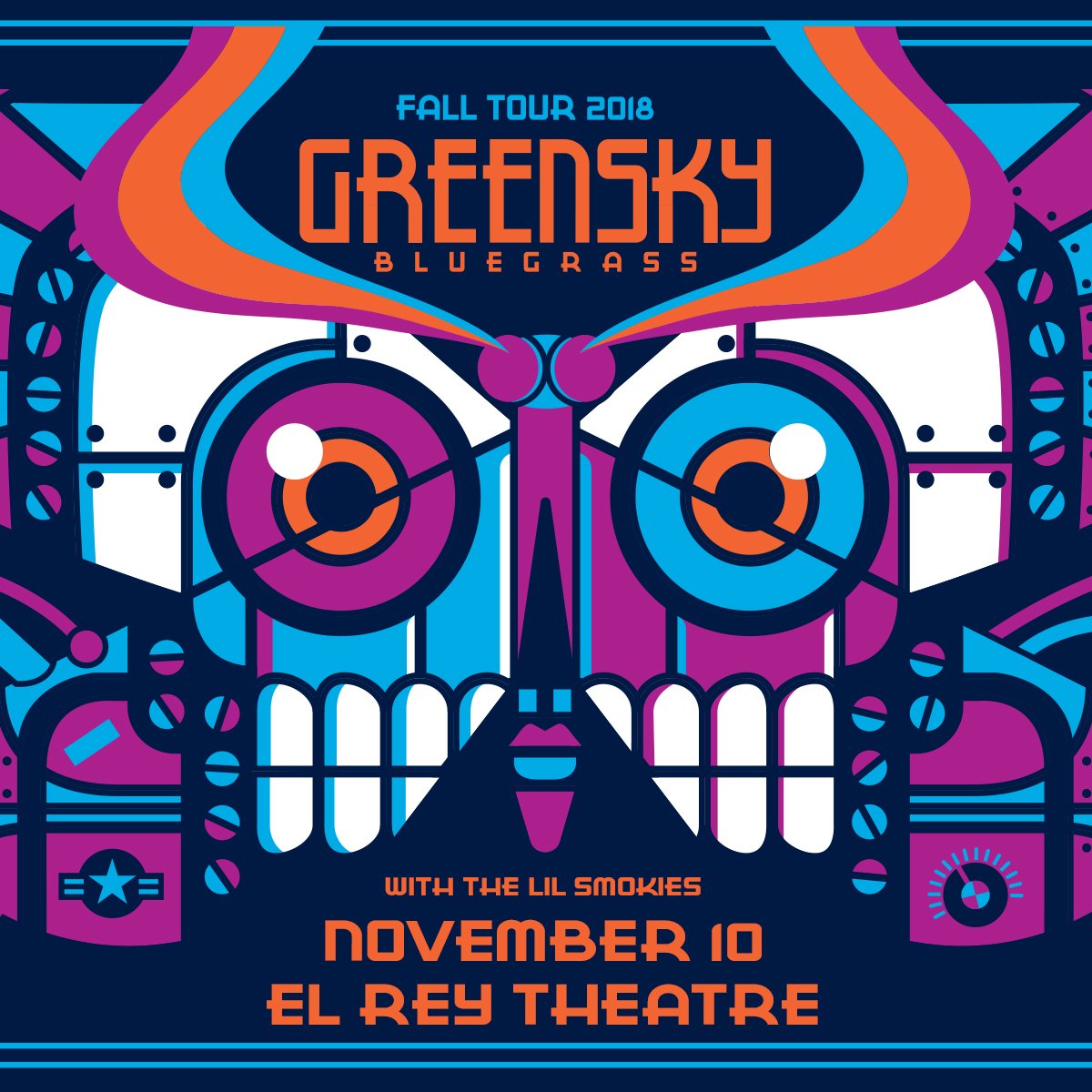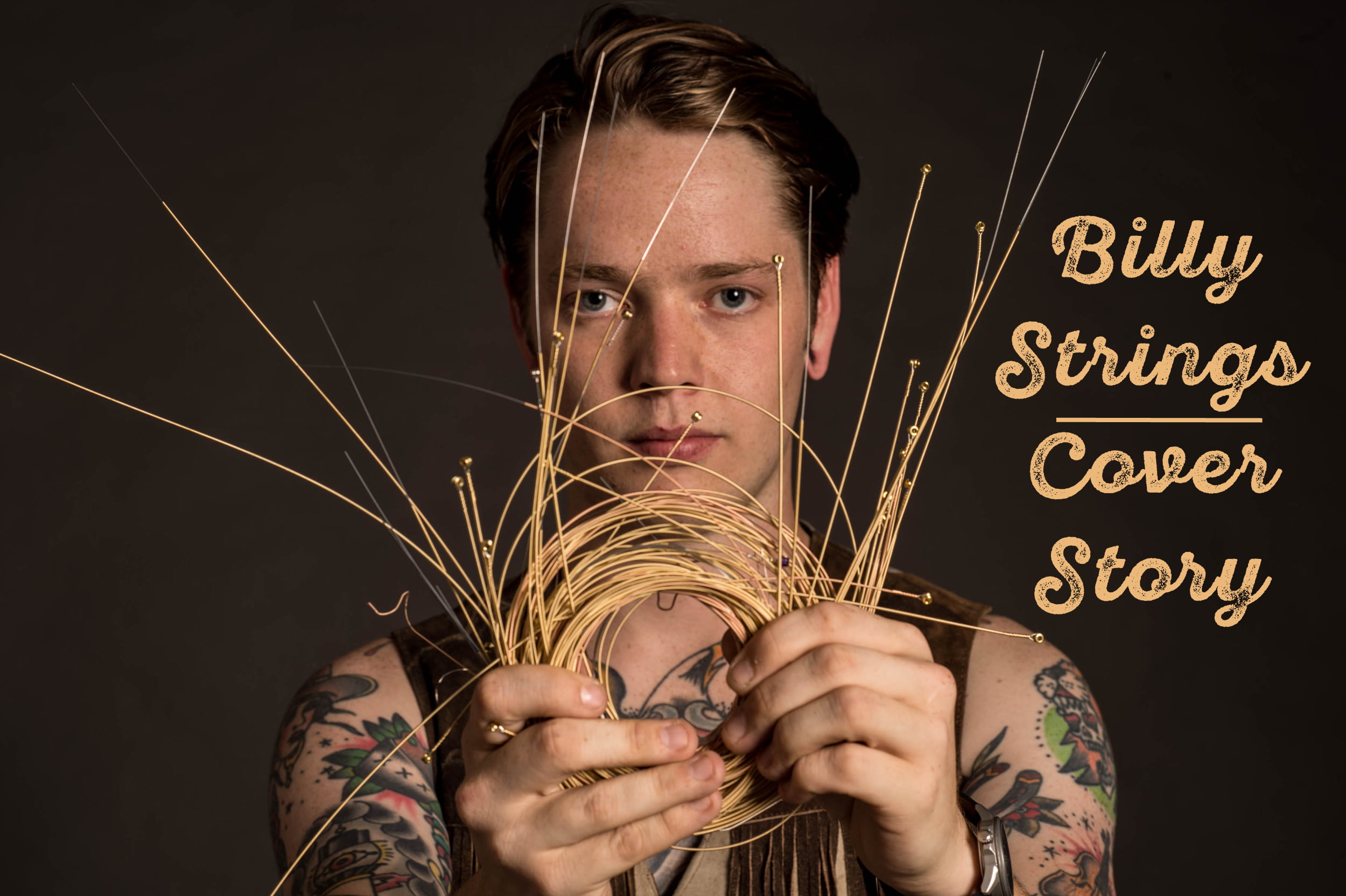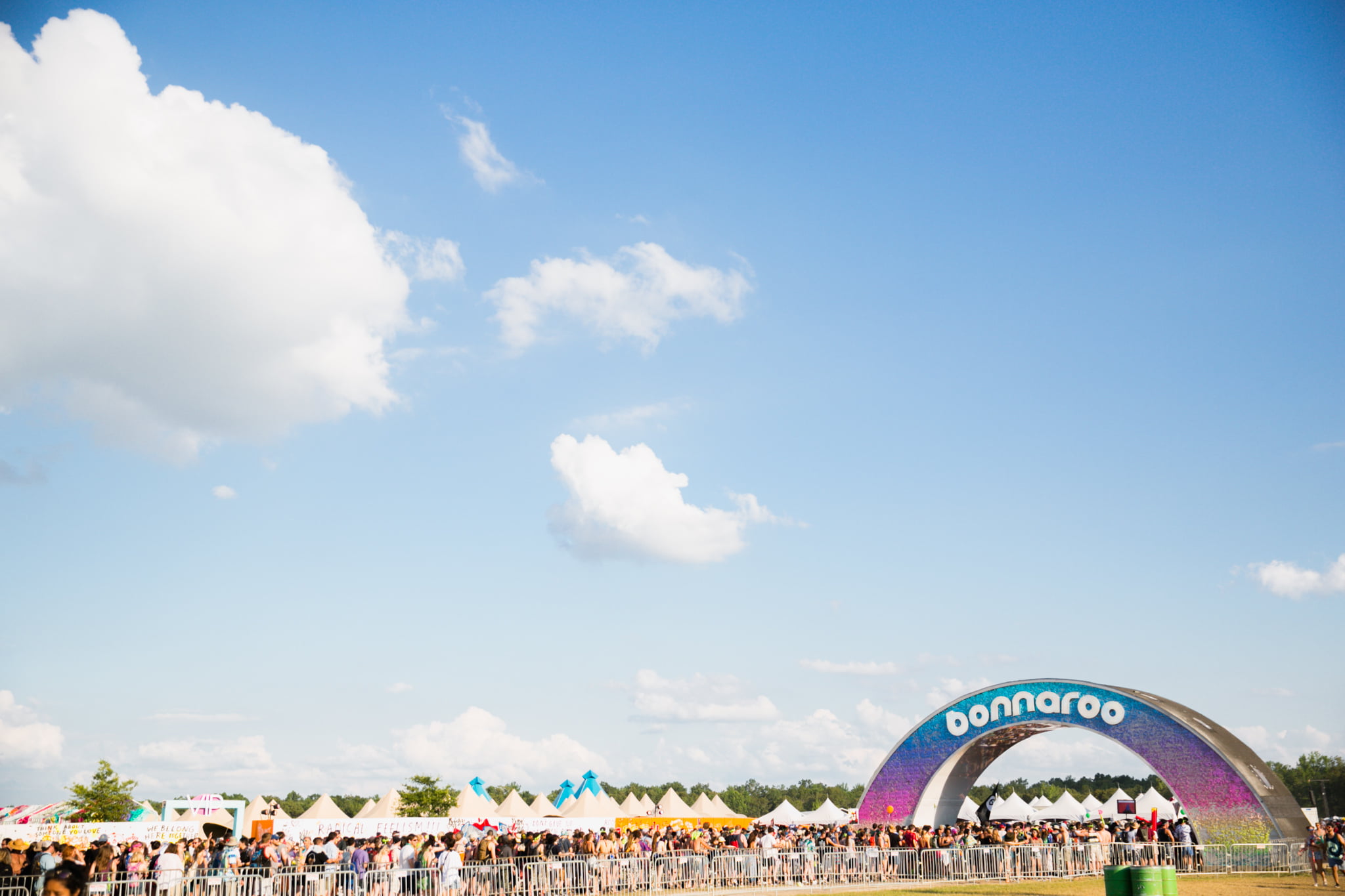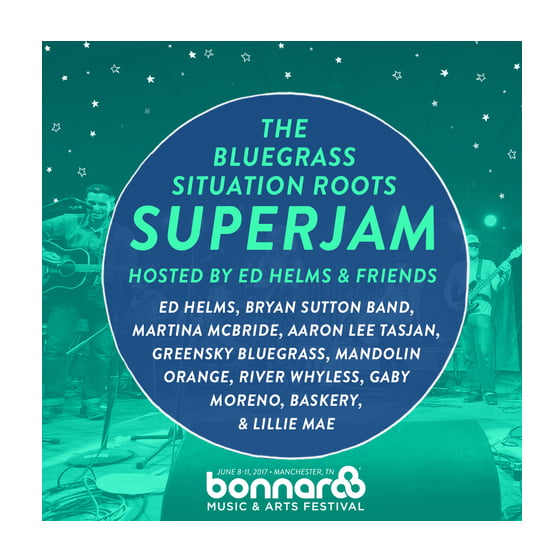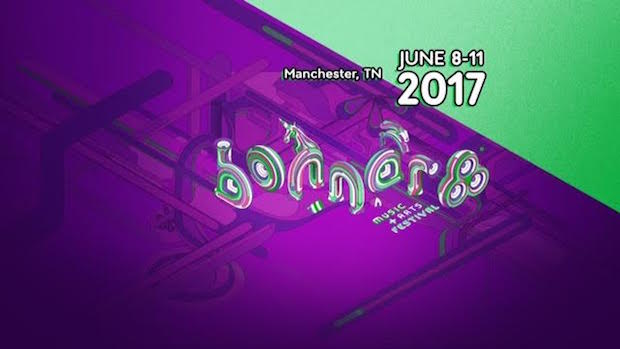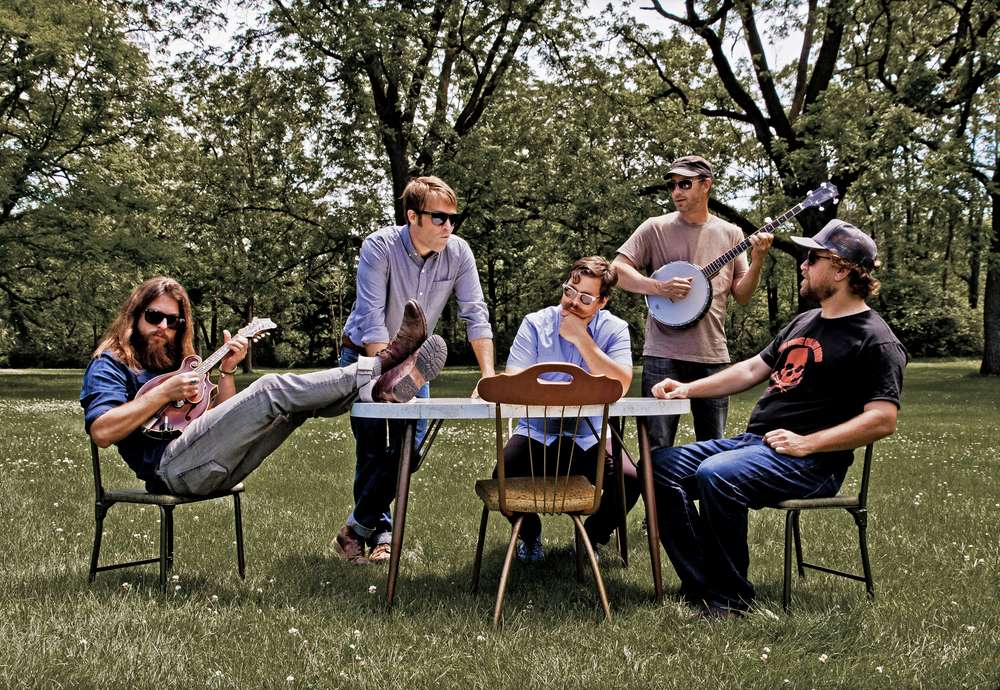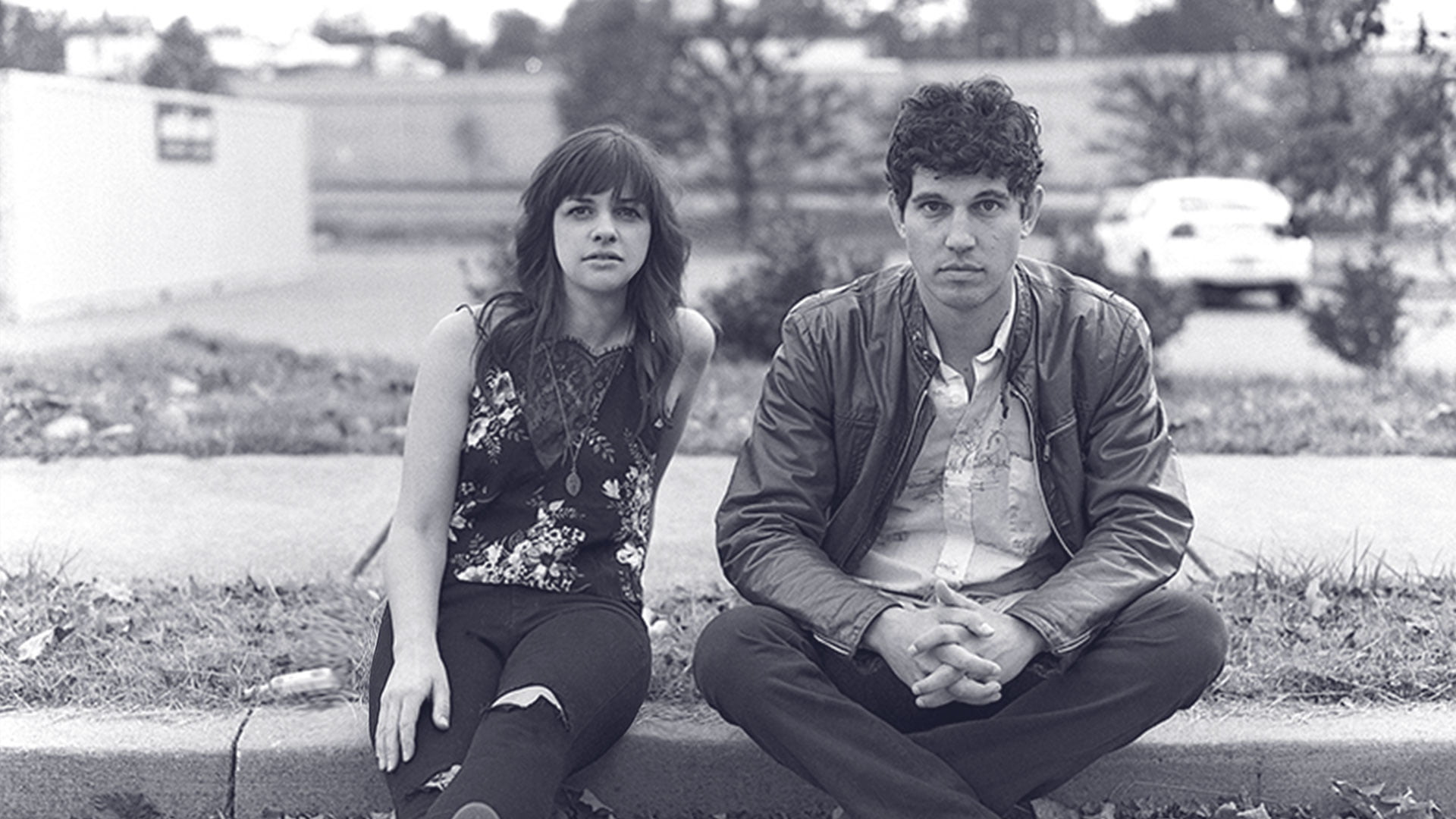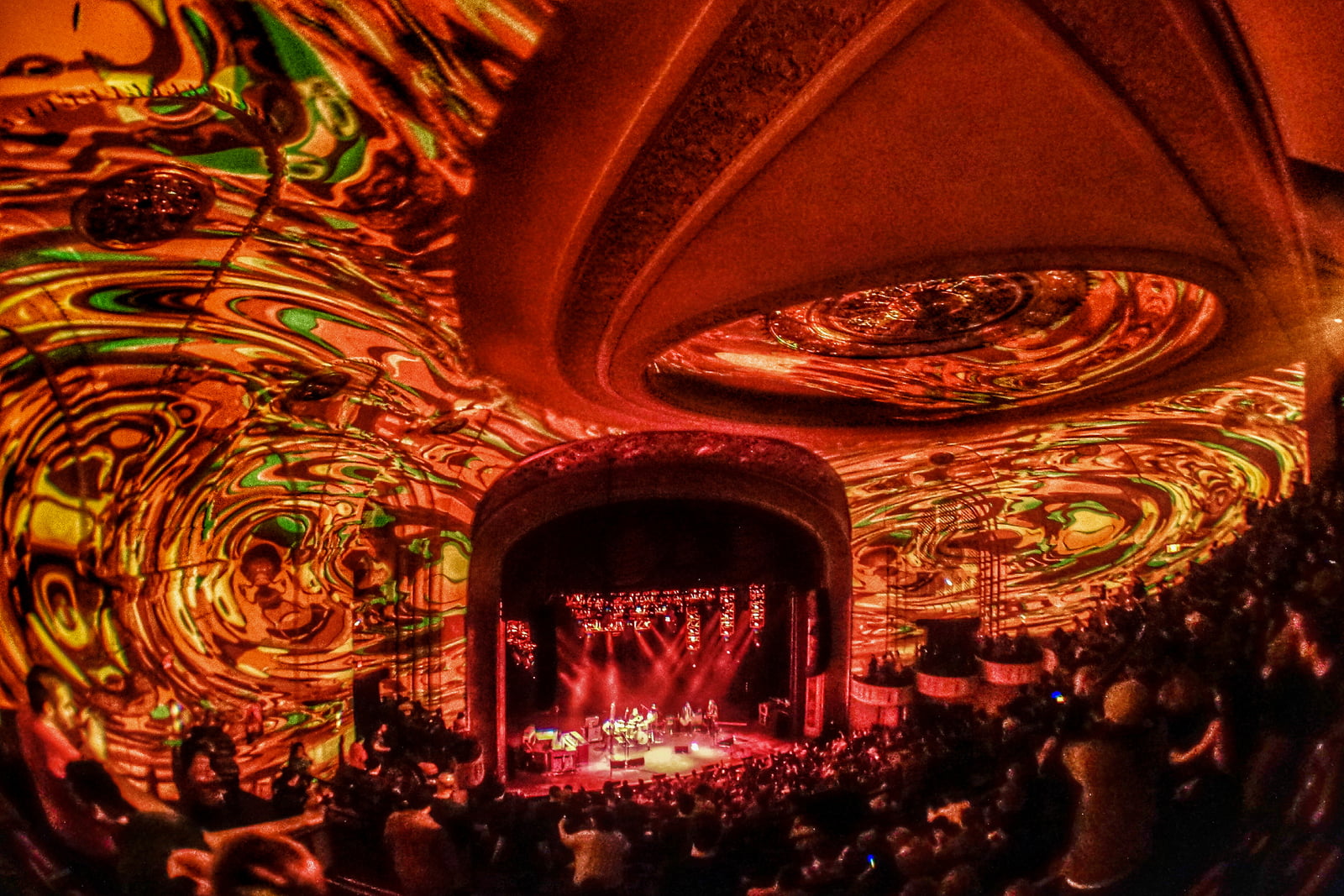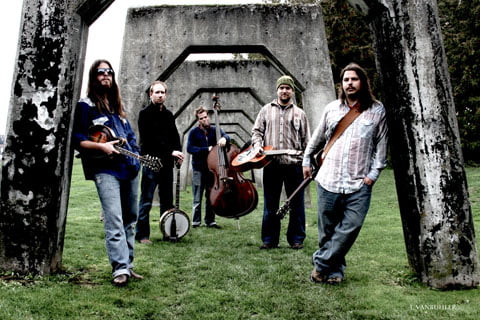Tag: Greensky Bluegrass
Jumping into the Deep End: A Conversation with Billy Strings
Guitar virtuoso Billy Strings (born William Apostol) is on the road somewhere between here and there, when he picks up the phone. That question “Where exactly?” gives him pause. “The other day, I couldn’t remember where I was,” he admits, a note of earnestness betraying his 25 years of age. It’s that sweet natured tendency the young have to overshare. “It took me probably at least 40 or 50 seconds just to go, ‘Oh yeah.’ I don’t know if you’ve ever felt that before, but it’s a really strange thing.” It’s the kind of problem that comes with being a popular bluegrass musician, and one he’s forever adjusting to as he zips from city to city. “We were in the van once, and I literally asked the question, ‘Is this where we are?’” he says with a laugh, knowing the existential weight of his own seemingly ordinary question.
Billy’s ever-probing mind, technical proficiency, and weighted voice all suggest a much older player. He recently released his debut LP, Turmoil & Tinfoil, recorded with Greensky Bluegrass’s producer, Glenn Brown, in the dead of Michigan’s winter. Even in that setting, it burns with a feverish heat. “It was like being snowed in, like cabin fever,” Billy says about the session, which could explain the album’s bracing pace. As much as he nods to tradition on Turmoil & Tinfoil, he also playfully stretches the bounds of bluegrass via face-melting guitar phrasing (thanks to his abiding interest in heavy metal, classic rock, the blues, and more) and socially conscious songs. Both the wounded “Living Like an Animal” and the frustrated “Dealing Despair” pry into issues of personhood and community at a time when both seem more fractured than ever. What others have termed his “authenticity,” Billy chalks up to “honesty,” and it serves, in a way, as his battle cry. He’s not afraid to keep asking questions, big or small.
Just out of curiosity, how many back-up strings do you bring on tour, given your penchant for breaking them in your wilder fits of playing?
Nowadays, I actually have three guitars onstage with me. I have two Preston Thompsons on stage, and then I have a Roy Noble on stage with me, as well. Rarely do I get to the third one anymore, but there have been times where I’ll reach for the Roy Noble.
So would you say, then, that a particularly crazy night on stage is a Roy Noble night?
Yeah, I guess so. You could.
Tradition has long been a defining force within bluegrass. How have you navigated your way through it?
I grew up playing bluegrass music and traditional bluegrass music, and I have a deep passion for that, as well, but I like all kinds of music.
Right, I know you’re a big metal fan, specifically.
Yeah, I love some death metal and some rock ‘n’ roll and blues. I like all sorts of stuff. When I was younger, I was a little bit more closed-minded about a lot of things, whether it was “Why would you want to play bluegrass but not bluegrass?” This or that, you know? But eventually I got out of that shell, and I want to get so far away from that “This is bluegrass and this ain’t” as I can. It’s just music. I’m just trying to let myself be free with music.
I think that’s something that we’re seeing a lot from the younger generation, bringing all these influences into the genre.
Definitely. I think there will always be a hint of traditional bluegrass in my shows because that’s how I learned to play guitar. My ears were trained by “How Mountain Gals Can Love” and “Blue Moon of Kentucky” — that’s the music I cut my teeth on. You’ll always hear it, I think, but I’m also going to do whatever the song calls for. I used to be embarrassed to show anybody a song that I wrote, and I’m just trying to ditch that whole mentality. Who cares if a song is that or this, or if somebody likes it or they don’t? It’s the song.
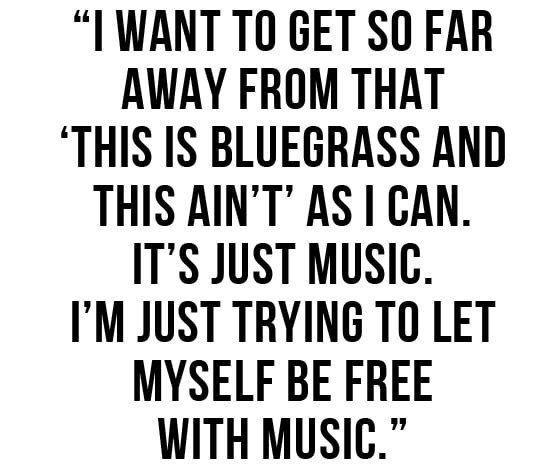
You’ve mentioned in the past that you’ve never learned anything note for note; instead, you just hear it and emulate it. What does your writing process look like, then, for original compositions?
It looks like me walking around my house with my guitar, staring at my reflection in the microwave. Pacing back and forth when nobody’s home, just scribbling on notebooks and stuff, and being on my Google Doc. I sit there with my guitar and I sing it and then, if I got something cool, I’ll write it down.
“Dealing Despair” is such a powerful original song in light of how divided the country seems. Where did that come from?
I actually wrote that quite a while back. It was after another unarmed Black man was shot down by police, and I was awfully pissed off. I was shook. I’m feeling it lately, too; there’s so much going on in the world.
It feels so divided. I mean, it always has been, but more than ever it seems.
Yeah, and we should just talk about music. But I’m feeling it lately, and you’ve gotta write about what you’re feeling, and that goes back to what I was saying about letting it happen and not worrying about if people are going to like it or not because certainly some people might take that song as a little aggressive.
I know some listeners keep clamoring for artists to shut up about politics and just be artists, but bluegrass has always been a space to sort through social issues.
Well, man, that’s folk music. Look at Woody Guthrie, Bob Dylan. You have to sing about that shit. You absolutely have to. It’s kind of our duty. I’m not going to punch anybody in the face. I’m not going to carry a gun. I’m not going to fight a war. But with my guitar, I will. All I have is my songs to fight back against the ugliness that’s out there.
But that fight exists as an “either/or” these days, and it can alienate certain listeners.
I want people that are loving and not cruel to each other to come to my shows. I really don’t care what anybody thinks. I’m just doing my thing.
Turning away from politics, your father also played on this album.
Yeah, he’s on the last track [“These Memories of You”].
I thought so! The harmonies have this interesting familial tone.
What you just said is a huge compliment to me. My voice sounds the best when it’s right next to his; I can’t sing with anybody like that. My dad didn’t even know that song. He just walked right into the studio, and I wrote the lyrics on a piece of paper, and he just did it. He knows how to follow me, and I know how to follow him. My dad is a seriously heartfelt musician. When he plays a song, he really means it. He’s not just saying the words.
You learned from him when you were younger, so what was that moment like in the studio?
He was so happy to be there. It was kind of like he was a little kid. He sits around the house and plays, but he rarely goes and plays on stage anywhere — let alone in a recording studio.
And look how the tables have turned.
Those moments are what I cherish the absolute most. For instance, when I was six or seven years old, I was learning “Beaumont Rag,” and I just played the rhythm, but I kept messing it up in this one part. Right in the middle of the song, I said, “Stop. Dad, why don’t you play it and let me listen?” I listened to what he was trying to say with the guitar, and I go, “Now, let me try it again,” and I nailed it. He started laughing. He reached over his guitar and squeezed my little hand. He called my grandmother and said, “Listen to your grandson right now!” I was a little kid, but I’ll never forget that moment. Now there have been several moments since then, like when I got to introduce my dad to David Grisman in real life because my dad introduced me to David Grisman when I was seven years old. We got to sing songs all night.
That is so wild.
Yeah, it is wild because we come from a tiny little town and it’s not always been easy, and our family has had a lot of crazy stuff. Those moments are super good for me because I feel like it’s that same thing: It brings me right back to when I got the “Beaumont Rag” right. It really pushes me, and there are all sorts of reasons that I’m doing this, but that’s a huge one — because mom and dad are proud. I’m so grateful that they turned me onto this music. My childhood was a lot of bluegrass. I’m so grateful for that because I love this music.
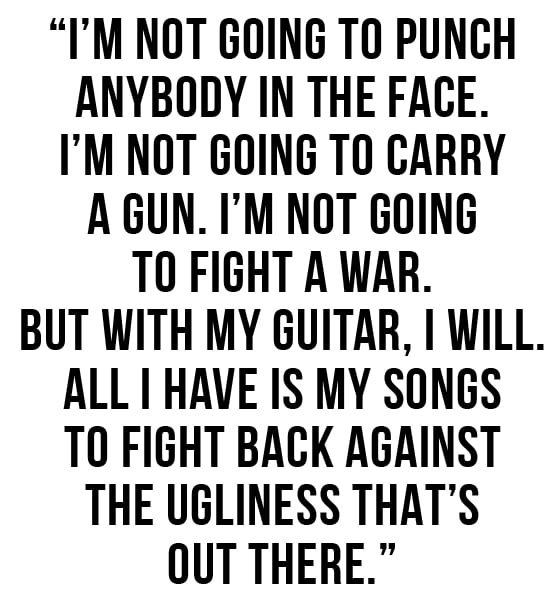
It’s interesting, too, because it seems like listeners are, in part, gravitating toward what they keep calling your authenticity. At 25 years old, that can be a loaded statement. How have you found your own way through that kind of praise?
I don’t know. I haven’t heard that word thrown around me that much.
Maybe not to your face.
Yeah, right. When I was talking about my songwriting, I’m just trying to do my thing and just be honest. Even in life. Don’t dip your toes in the water; just jump right into the deep end. Don’t get yourself into a situation that you don’t want to be in because you know what you really want. Don’t lie to yourself. Just be yourself.
You are wise beyond your years.
I think a lot, you know?
That comes across in your playing, too.
When I’m playing, it’s easy to learn a song and go through the routine and just play it night after night. But when I go out on stage, that’s not what I do. I try to actually pour it out with my guitar, from my heart. If you listen to a lot of the people I grew up listening to — Mac Wiseman, Bill Monroe, Larry Sparks, Keith Whitley — when they’re singing, they’re not kidding. That’s why you can cry when you hear it. I love players like that. And there’s so much music out there today, you know Top 40 everything, that’s garbage.
Well, it’s too constructed, but I can see how your dad shaped you to sing from the heart.
Every time he picks up the guitar, he does that.
What a great way to learn.
I also learned a lesson from Sam Bush without him saying anything. I leaned over and took a drink of my beer — this was quite a while ago — and I looked over at Sam Bush and he had his eyes closed playing the hell out of the rhythm. It’s like, “Why do I think that I can just stop playing the song right now to take a sip of beer? Wake up, kid. You’re playing a song. What are you doing?” It’s that attitude. Whenever those dudes play, Sam Bush gives it 110 percent. Bryan Sutton was telling me the other day that Doc would never pick up his guitar and just play a little ditty or half of a song; he would always play the whole song.
Speaking of Bryan, I know you collaborated on “Salty Sheep.” How did that come about?
I think I just called him and asked him. [Laughs] It was so amazing for me. We sat a microphone in between us, and we sat in two chairs really close to each other, just facing each other. With no headphones on, we just played the tune a couple times, and holy shit.
Well, talk about Doc Watson vibes.
Well, that’s what me and him geek out on. When we go to lunch, we’re always talking about Doc Watson. We both love him so much.
So we can expect a covers album from you two soon?
I have no idea. I’m down, but you’d have to ask Bryan. He’s such a wonderful friend and mentor. He’s done this 20 years, and he’s got a lot of advice for a young guy like me. I’m so grateful for that advice. He just gives it away for free because he’s a good friend and he cares about guitar and Doc’s legacy and all that. I’m honored to have him as a friend, and completely honored to have him on the record.
RECAP: The BGS at Bonnaroo 2017
River Whyless stepped onto the stage at That Tent while the temperature was still bearable, the dust was still minimal, and the sky was bright blue — that signature Tennessee summer haze would come later. Their fiddle and harmonium wafted out over Centeroo like a roots music call to prayer. The BGS stage had begun!
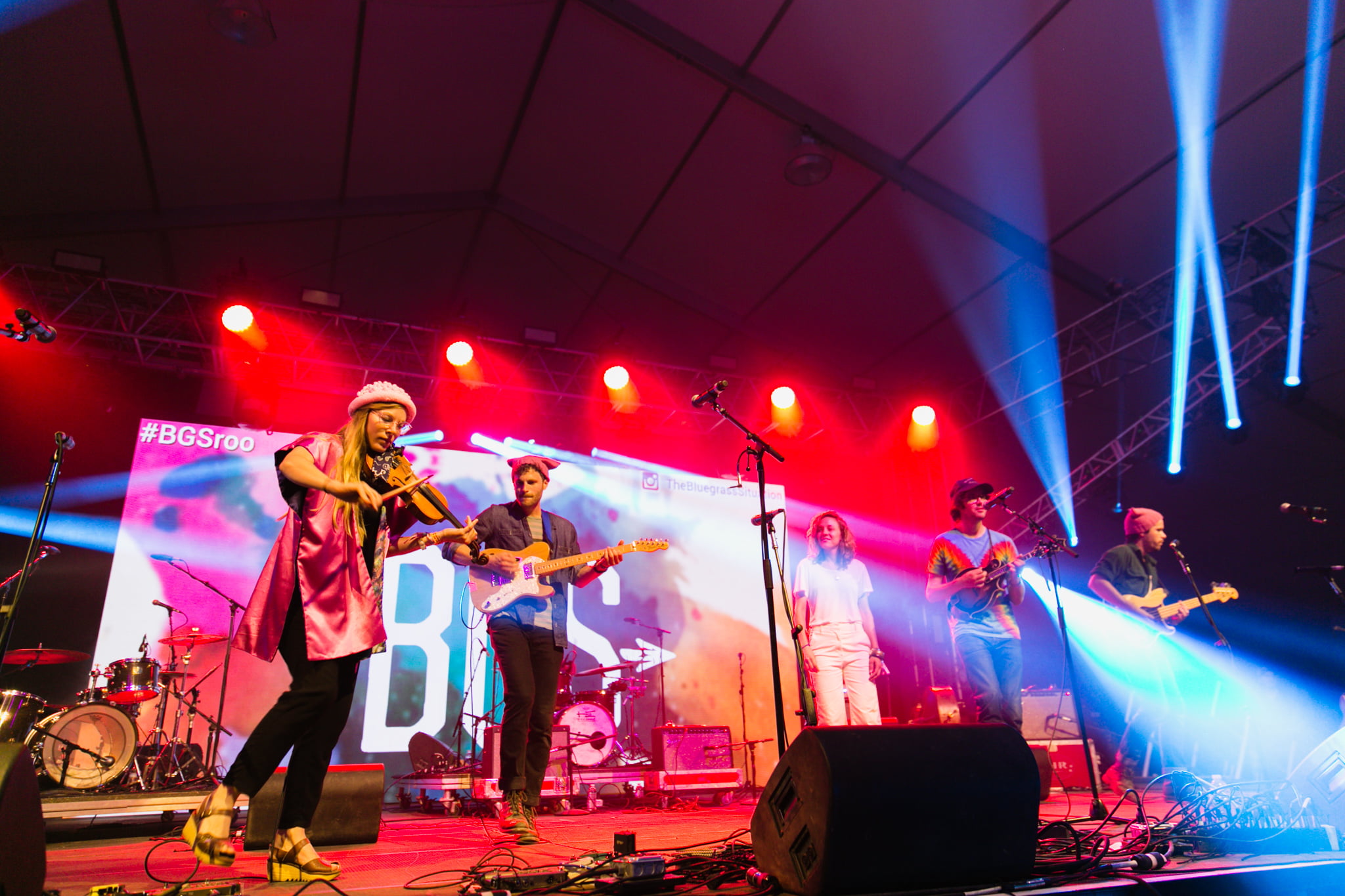

Aaron Lee Tasjan and company took the stage second, with double-drummer power and super-dapper duds. Earlier in the day at the daily press panel, Tasjan referenced iconic one-liner comedian Mitch Hedberg as a personal songwriting influence and inspiration. It seems an unlikely reference point for his rockabilly-infused, hot-and-heavy rock ‘n’ roll, but it all made sense watching him live. There’s a darker, sly, unexpected humor to ALT.
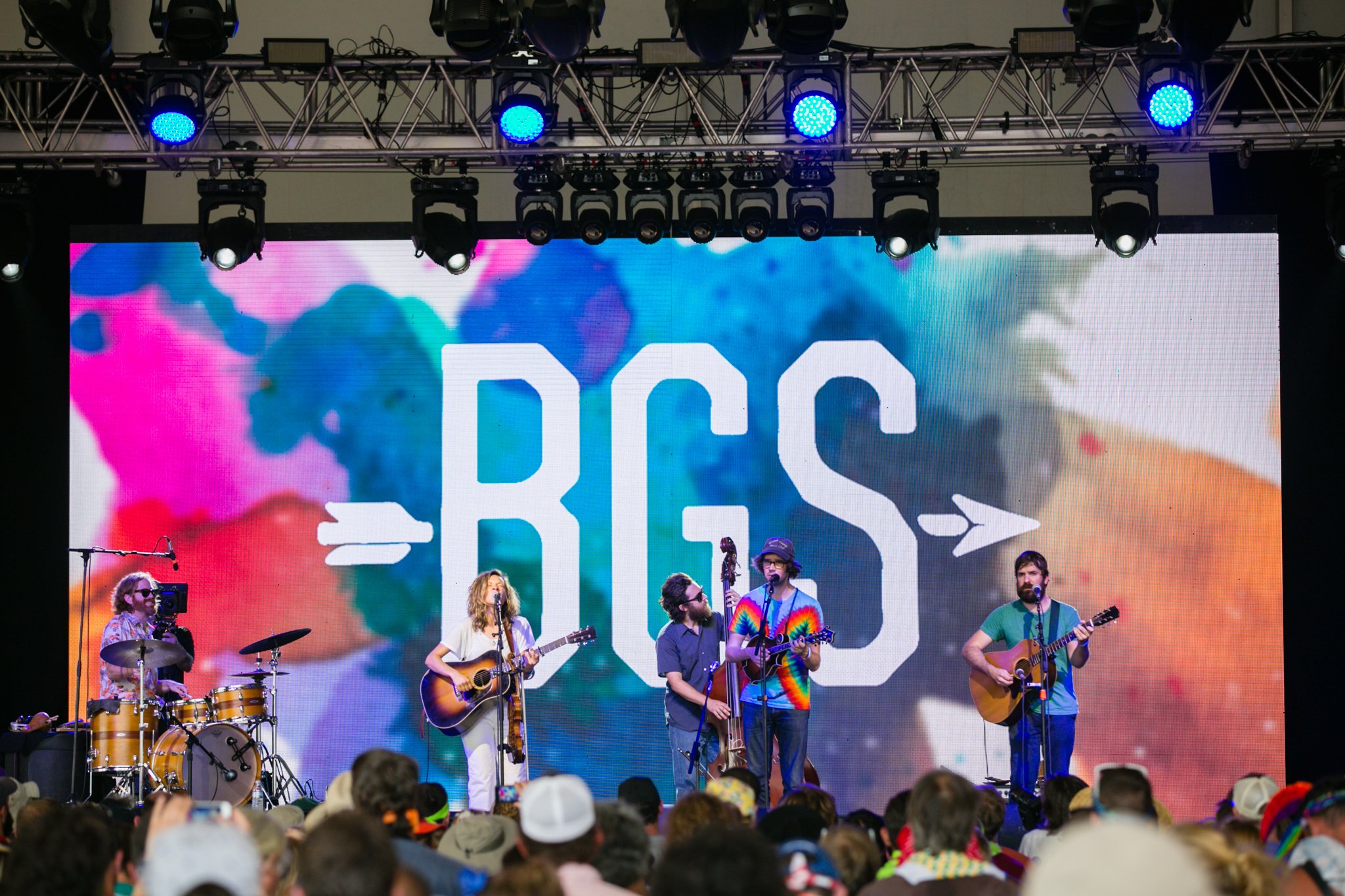
Our longtime friends Mandolin Orange came third, playing with a full band — Emily Frantz in pure white head to toe, looking summery and fresh despite the now-ridiculous temperature, and Andrew Marlin lending festival cred to our entire operation with his rainbow tie-dye tee. They sprinkled old favorites in and among songs from their latest album, Blindfaller.

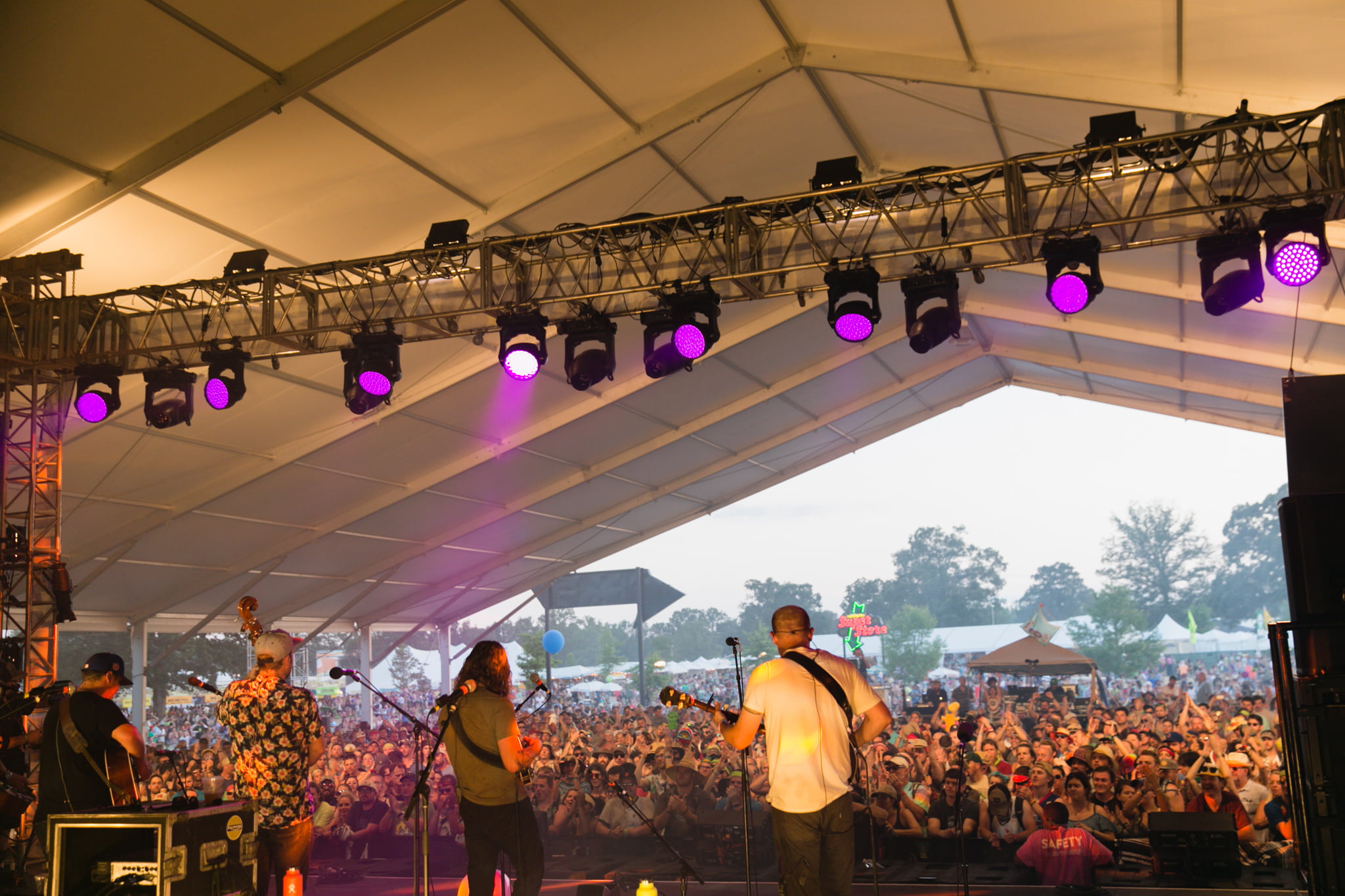
The crowd had now totally pushed the blanket, beach towel, and inflatable hammock loungers out of the tent, as more and more fans packed the front of the stage for Greensky Bluegrass. Their long jams, lighting design, powerful vocals, and incredible energy brought out the loudest, most raucous cheers and applause from the audience all day. No surprise there! You could hear the crowd roar from almost anywhere in Centeroo.
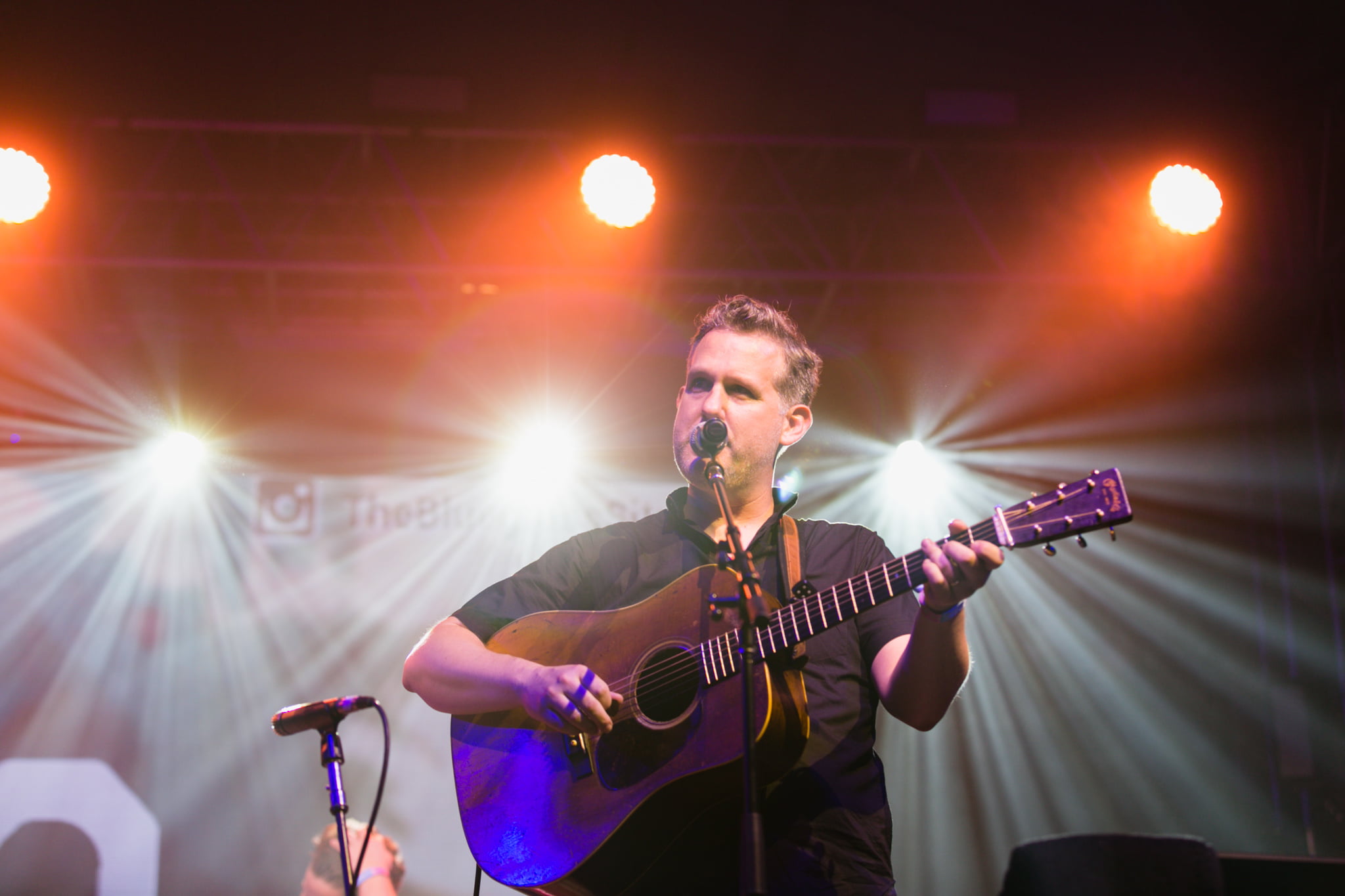
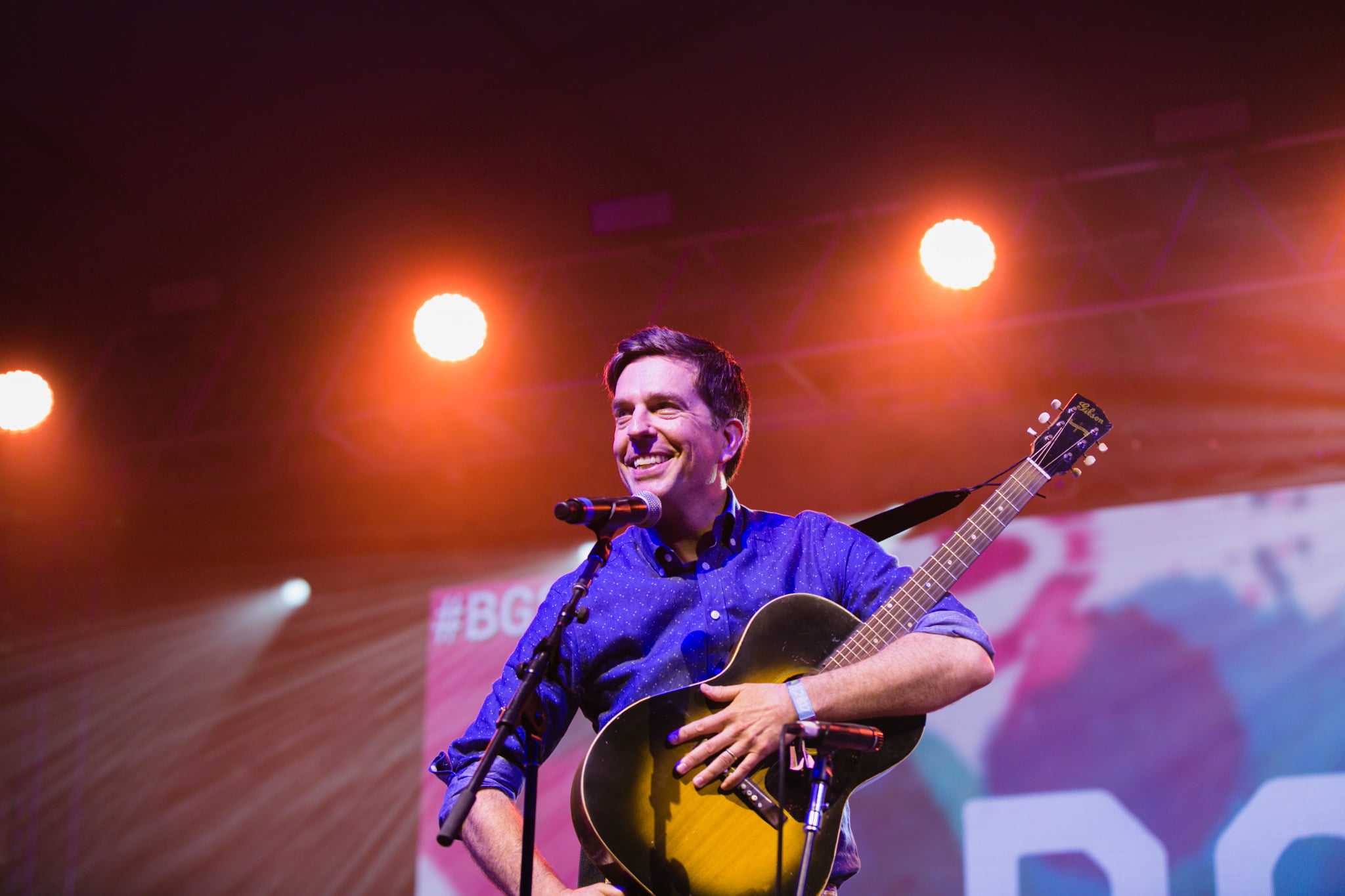
As Greensky finished their set and exited — to one more round of thunderous applause — dozens of stagehands, artists, and musicians descended, transforming the stage in minutes. The lights came down and the crowd cheered as the Bryan Sutton Band (seriously, could there be a better house band?) tore into a bluegrass medley of “Walkin’ Across This Land” and the burning instrumental “Cricket on the Hearth.” Then, to cheers and hoots and hollers and whistles, Bryan introduced “Andy Bernard” and “Captain Underpants” — aka BGS co-founder and our SuperJam host, Ed Helms. Ed sang Doc Watson’s bluesy “I Am a Pilgrim,” before welcoming back River Whyless to play CCR’s “Fortunate Son.” Baskery, a Swedish Americana (Swedecana?) trio who had performed earlier in the day at the New Music on Tap Lounge were next, performing a bluegrass-tinged, folky cover of Paul Simon’s “Graceland.”
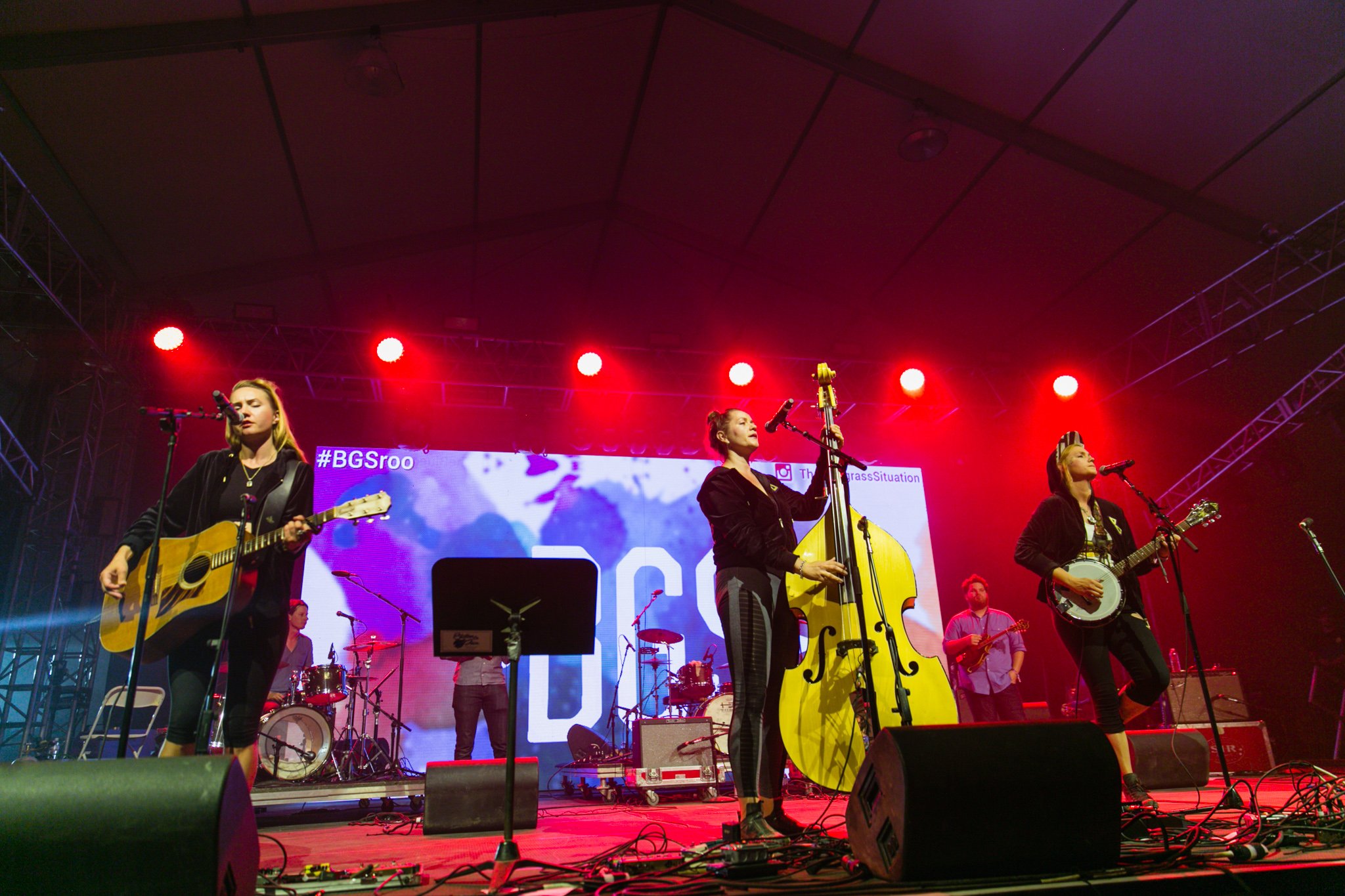
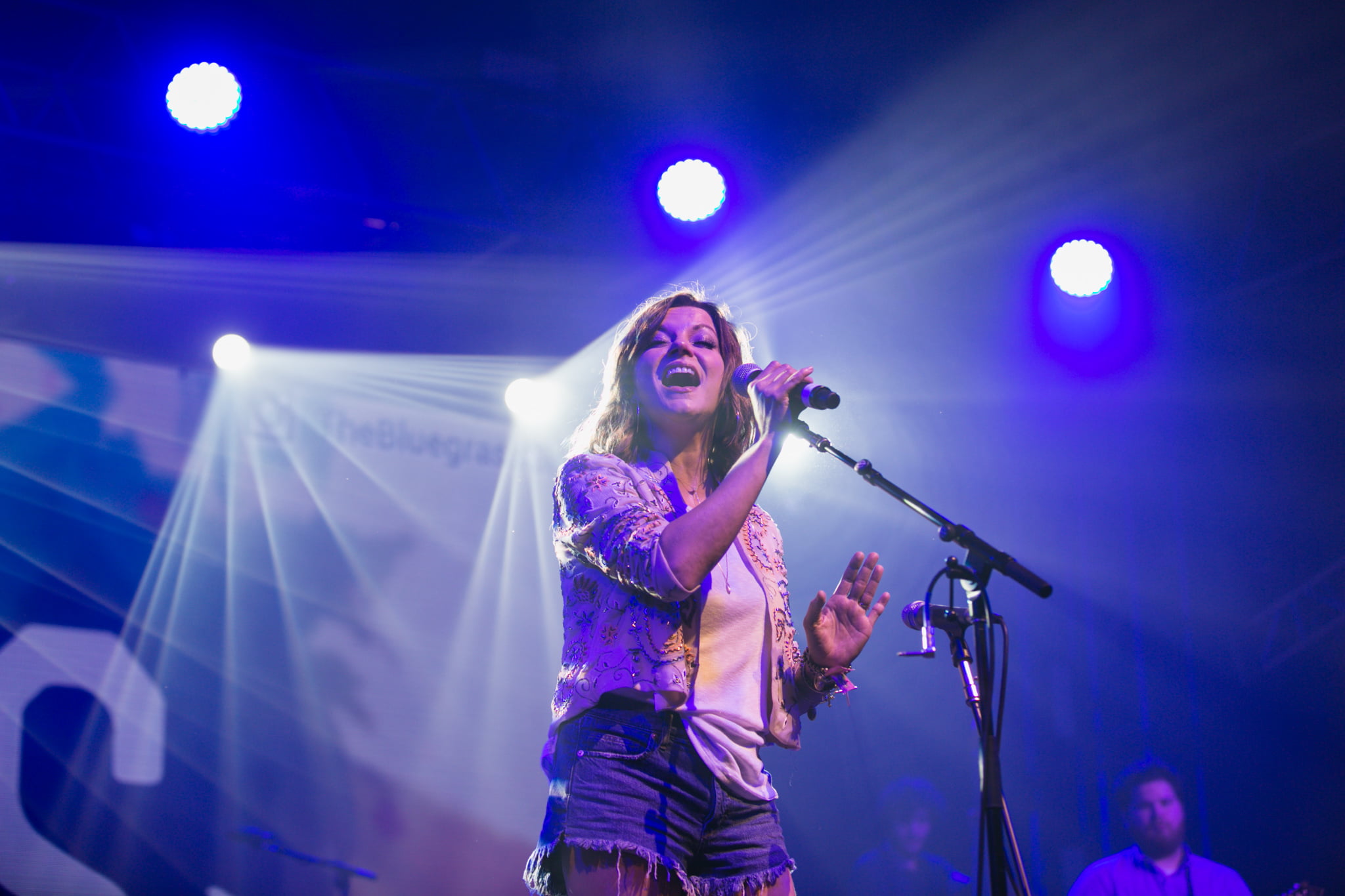
Mandolin Orange returned to the stage and led an epic, all-tent sing along of “Strawberry Wine,” a song perfectly fitting for Bonnaroo. Martina McBride followed, knocking all of us out with her fringed boots and her stunning cover of the Beatles’ “Blackbird,” continuing the sing-along vibe. The night wouldn’t have been complete without a Dolly Parton, Emmylou Harris, Linda Ronstadt Trio cover, so Baskery came back out to join Martina on “Those Memories.” No one in attendance will forget those memories anytime soon!

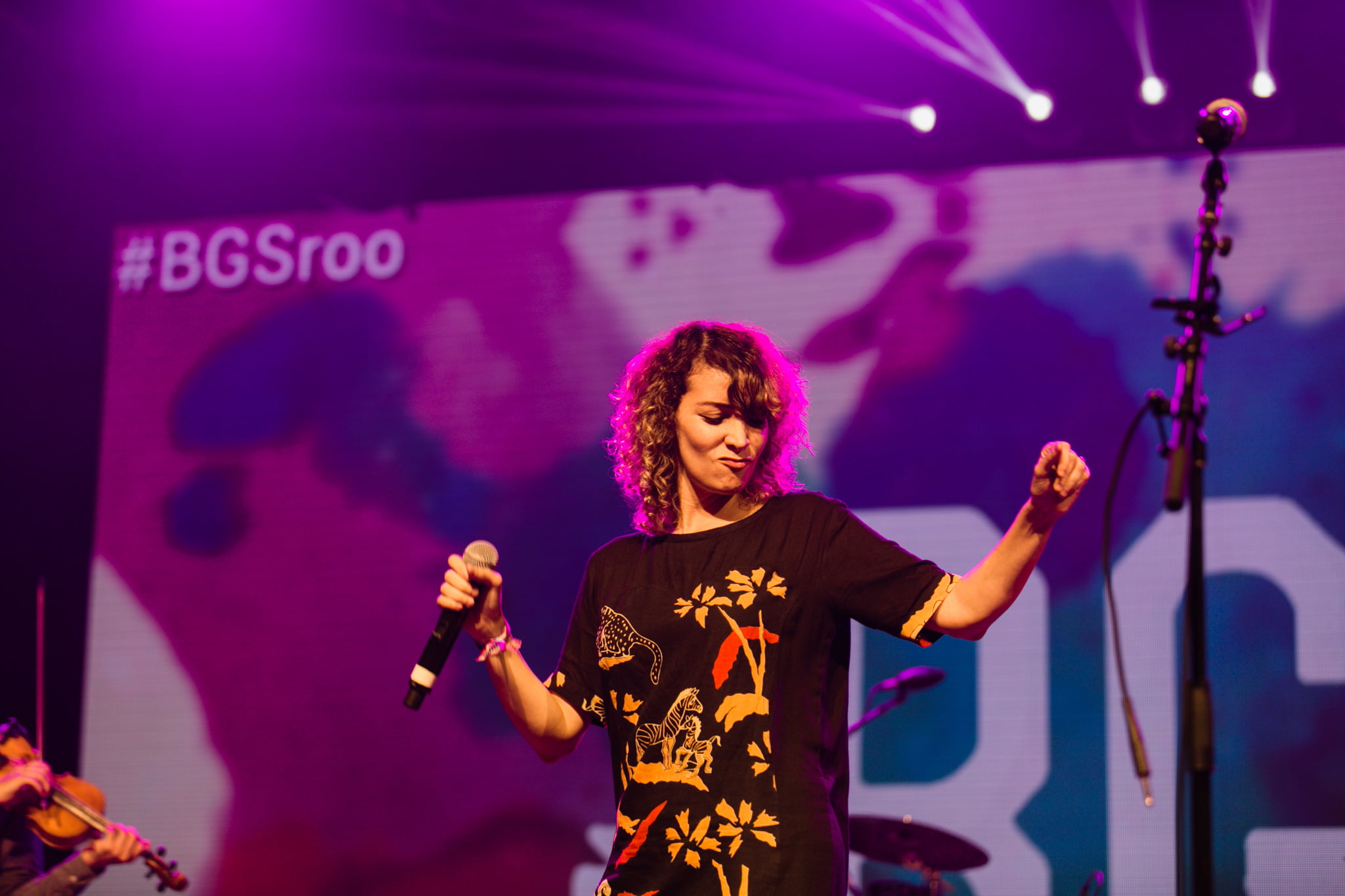
A couple of bluegrass tunes later and Aaron Lee Tasjan was welcomed back to promptly tear through Todd Snider’s “Pretty Boy” with the Bryan Sutton Band going electric. The incredible Gaby Moreno was next, giving the audience a muah muah muah muah “KISS” — we want more Gaby sings Prince, please!
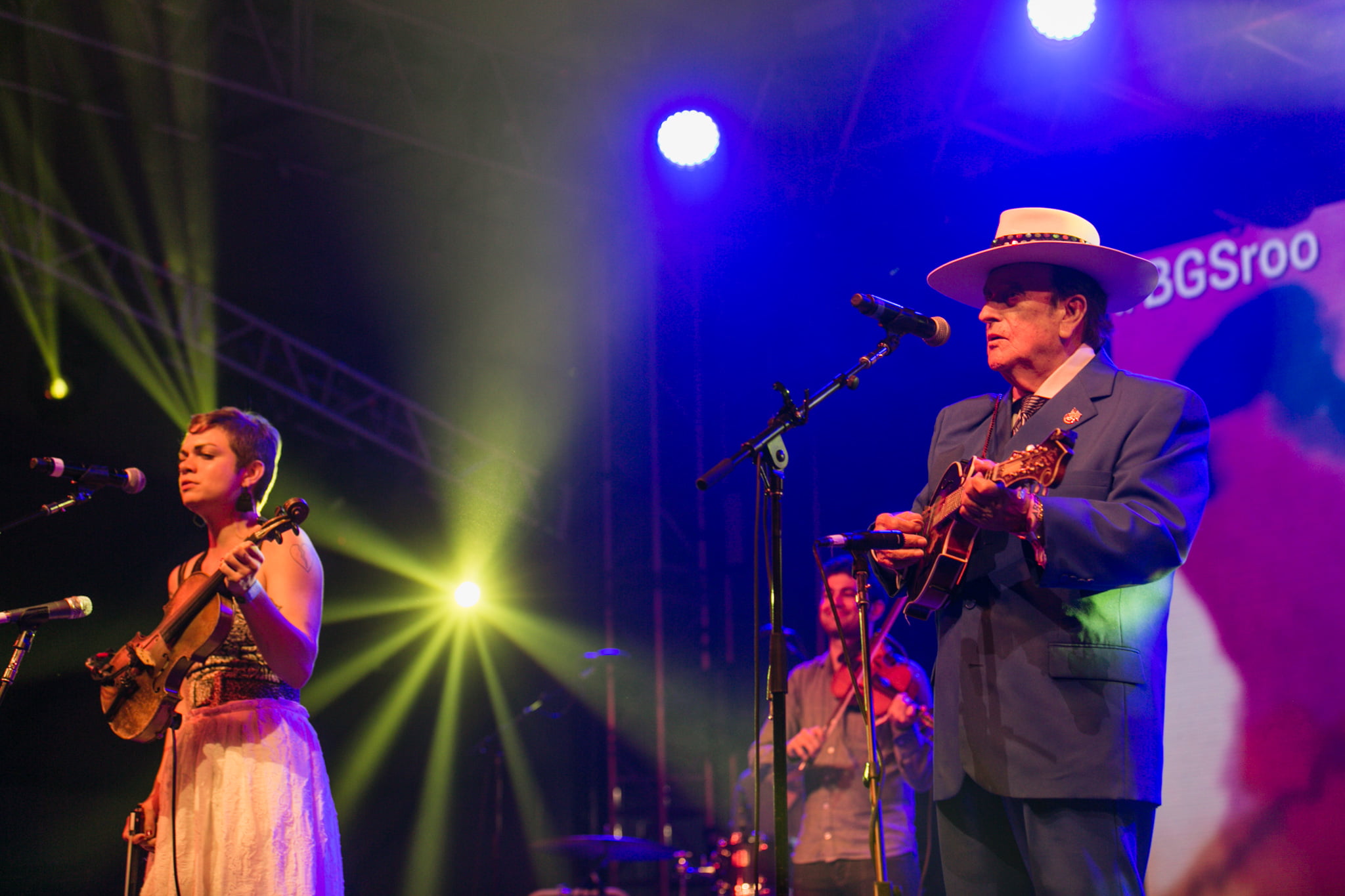
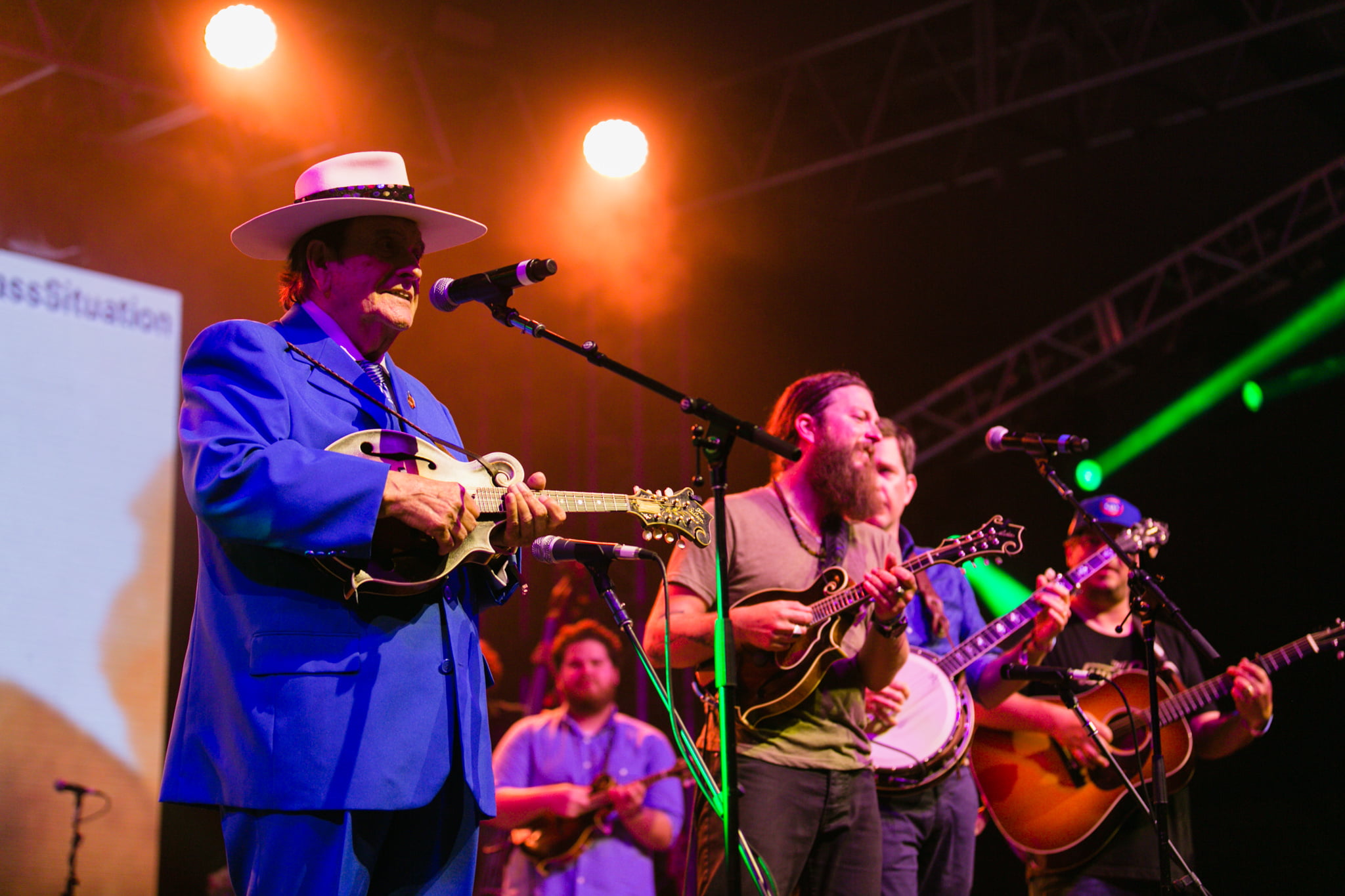
One of the most moving moments of the night came when Lillie Mae stepped on stage to introduce one of her heroes — the bluegrass living legend, Bobby Osborne. Before he had played or sung a single note the audience applauded for a solid two minutes. Seeing an enormous crowd at a music festival like Bonnaroo acknowledge the talent and impact of Bobby Osborne was outright stunning, but Lillie Mae, Bobby, and Bryan’s three-part harmony on “Beneath Still Waters” was earth-shattering. A long, long round of applause came again. On “Once More” they struck up an amazing three-part blend … once more. At 85, Bobby has still definitely got it and Bonnaroo knew it.
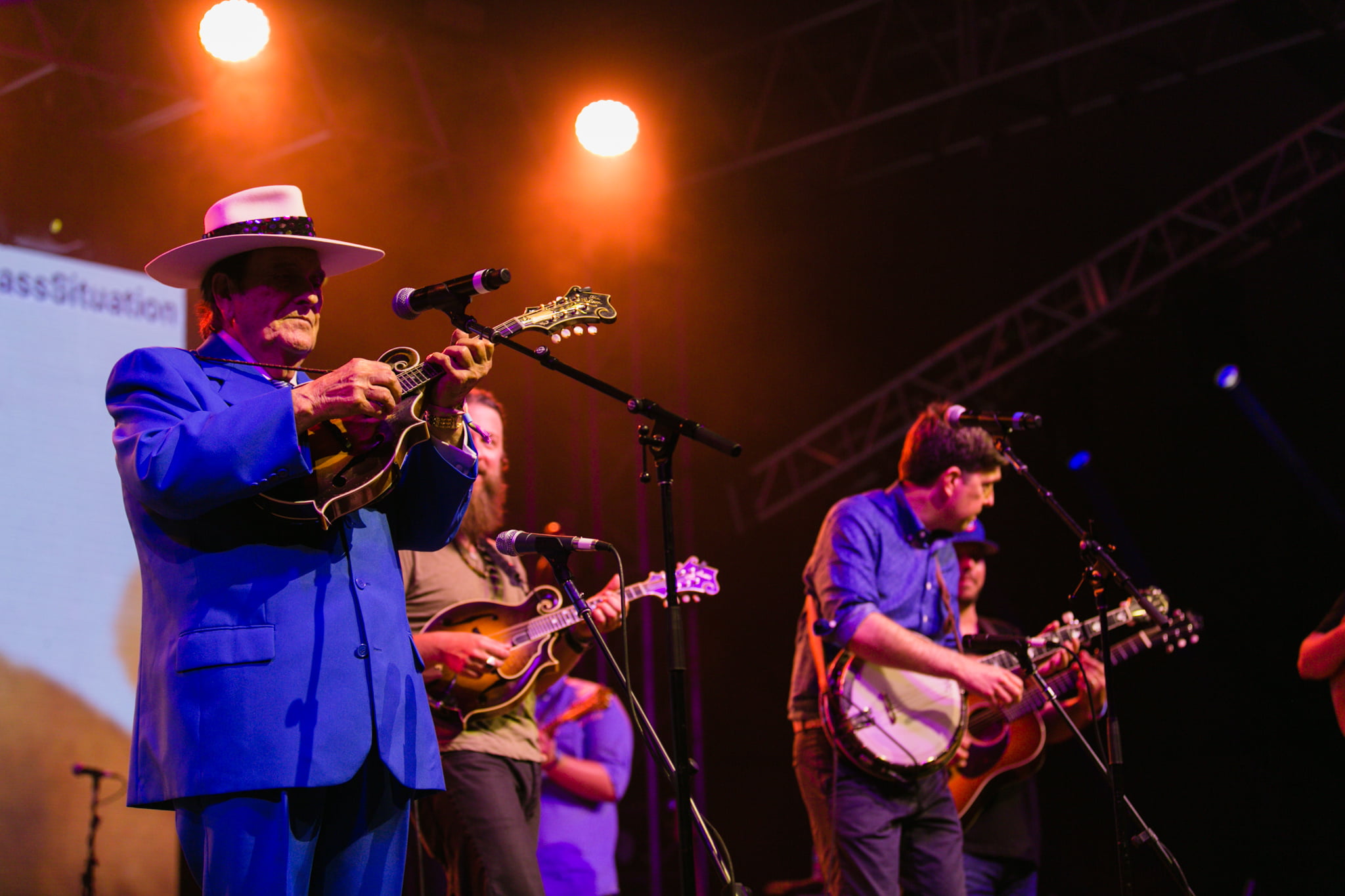
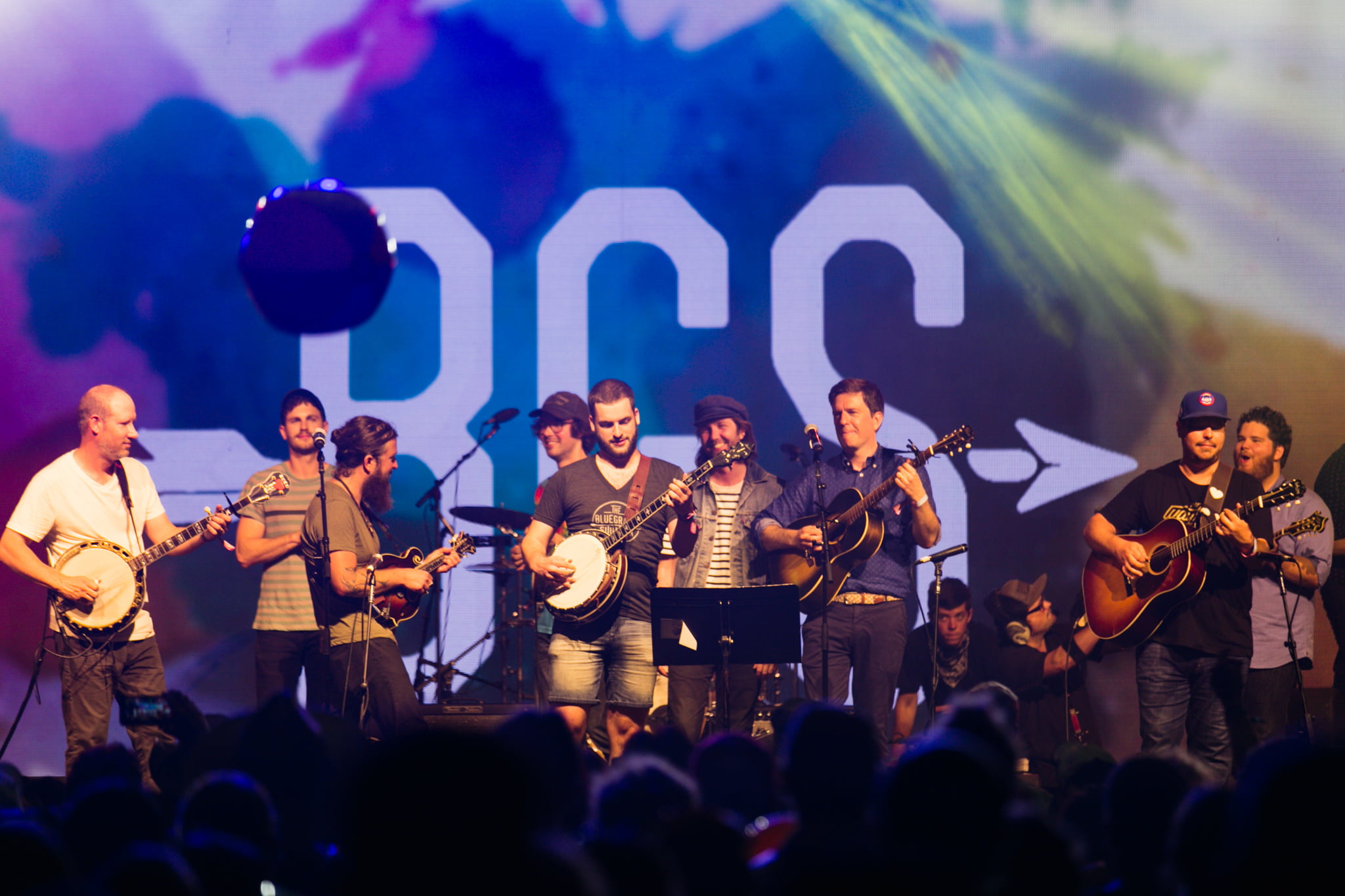
Greensky returned to the stage once again to cover the Boss, rocking it out on “Atlantic City.” Ed called the whole cast back to the stage, Bobby in his bright blue suit and iconic hat, among them. From somewhere in the crowd, someone shouted “Rocky Top!” Others agreed. They knew what was coming. Ed kicked off the Tennessee state song on banjo and Bobby sang the iconic lyrics that he and his brother Sonny first made famous. Not a single person in That Tent or overflowing out of it did not sing along.
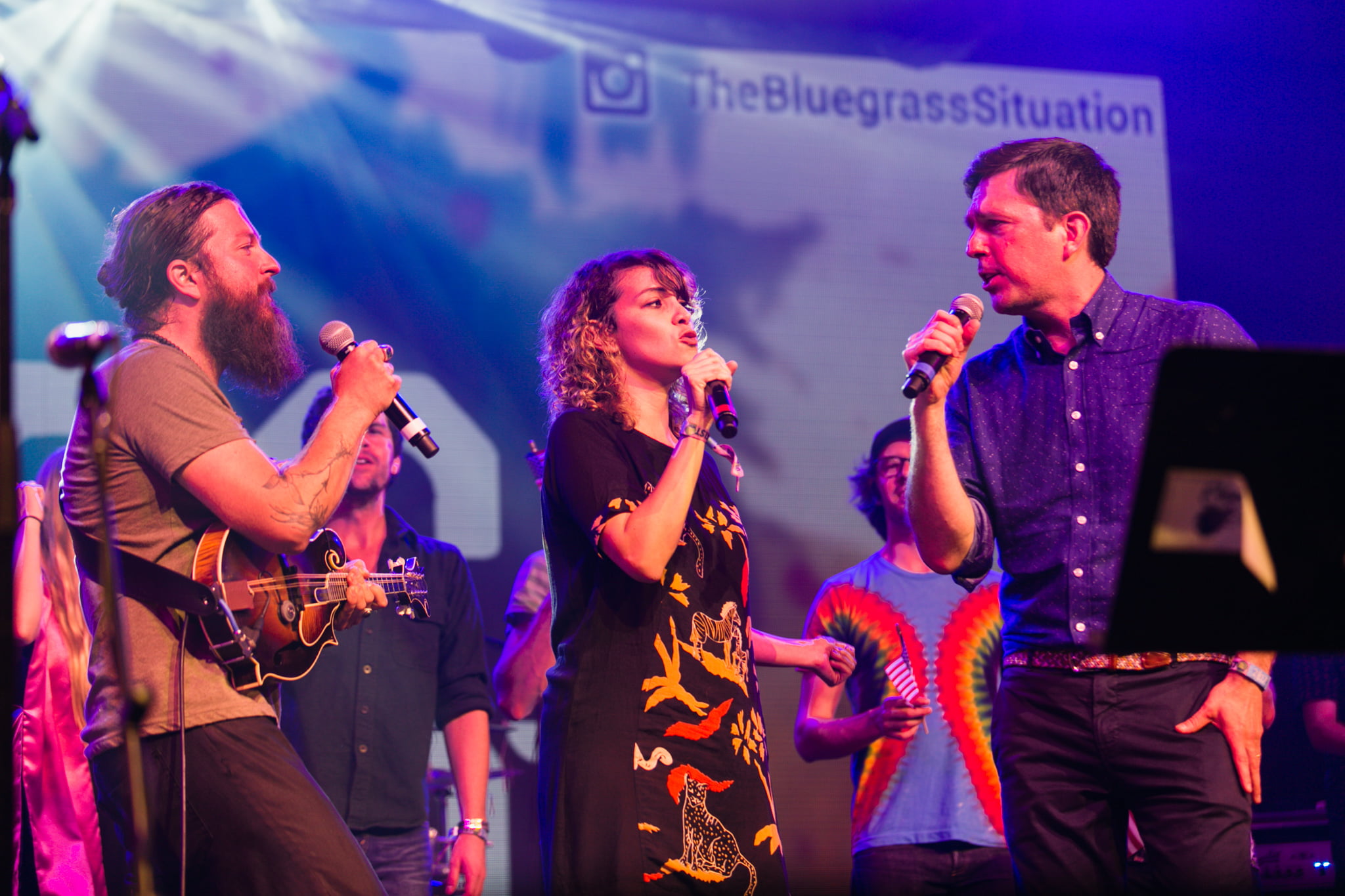
For the grand finale, Ed introduced our closing number. Waving U.S. flags on stage, the whole group belted and swayed to the unforgettable, patriotic lyrics of “God Bless the USA.” The climax of the song was not its final chorus, with dramatic stop and crash cymbals though, it was its second chorus, when Gaby Moreno stepped forward and sang in Spanish:
Nunca voy a olvidar
Ni a los inmigrantes
Que luchan hoy
Con coraje, amor y fe
Esta tierra es rica en diversidad
God bless the USA!
Where I live in freedom
I’ll never forget those who died
To give that right to me
Nor all the immigrants
Who fight today
With courage, love and faith
This land is rich in diversity
God bless the USA!
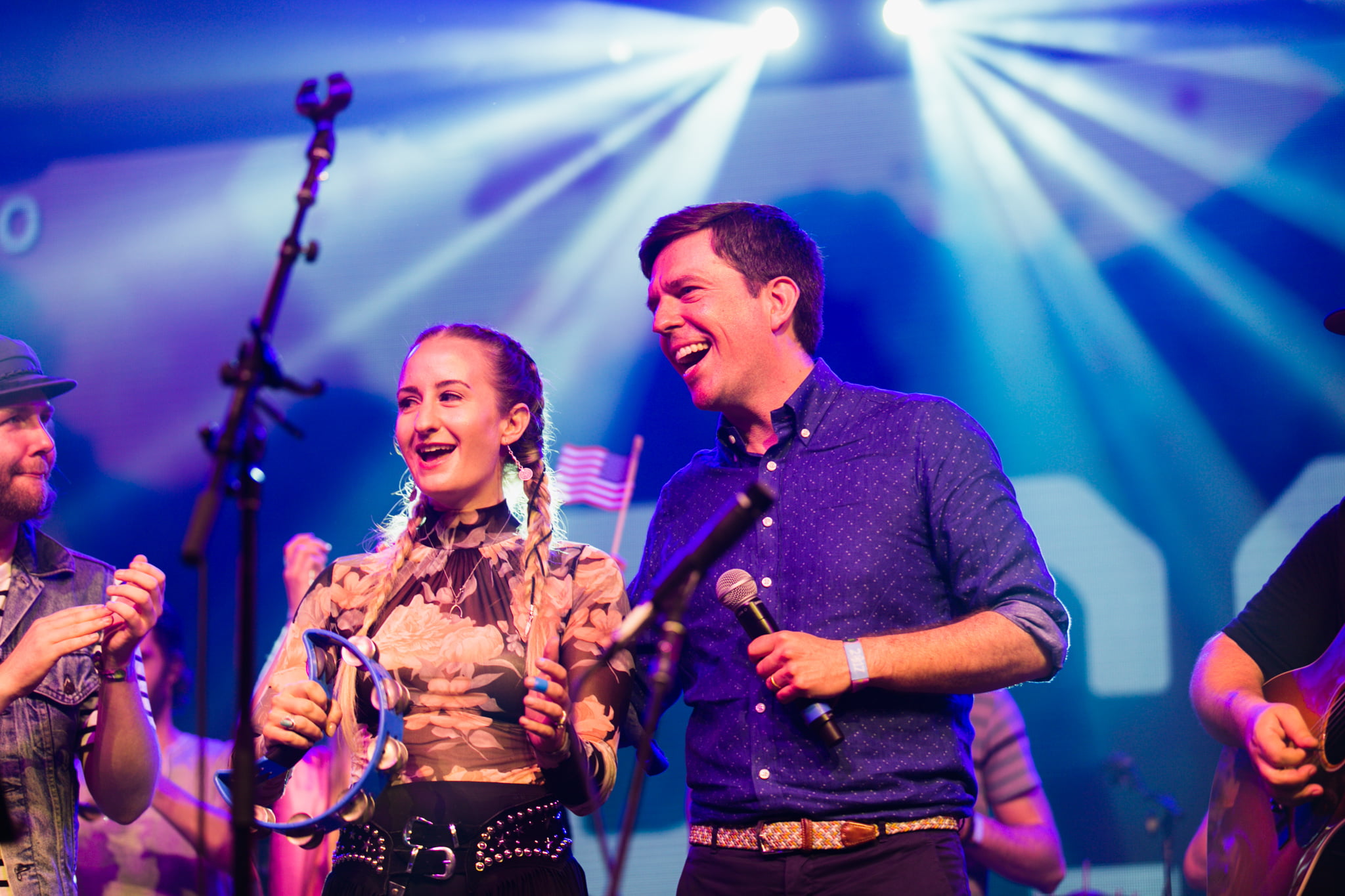
And if that wasn’t exactly what the world needs right now, then it must need John Mellencamp. Right out of “God Bless the USA,” Bryan Sutton morphed the song into “R.O.C.K in the USA.” Last-minute, surprise guest Margo Price sang a verse and rocked out on tambourine with long-time friend Aaron Lee. The musicians all traded solos, launching a friendly musical battle between Greensky’s Anders Beck and Paul Hoffman, as Gaby and Martina shouted along and U.S. flags still waved. Then, Ed signaled the band to drop out, leaving just the crowd singing, jumping up and down with beach balls flying — and our fifth annual Bluegrass Situation SuperJam hosted by Ed Helms came to a close.
ANNOUNCING: BGS SuperJam at Bonnaroo 2017
You probably already know about the BGS Stage at Bonnaroo 2017 happening on Sunday, June 11 with Aaron Lee Tasjan, Greensky Bluegrass, Mandolin Orange, and River Whyless. But, once again, we’ll be hosting our fifth roots music SuperJam to close out the last night of ‘roo.
As always, the Bluegrass Situation brings together the best of bluegrass, Americana, folk, and country for a rip-roaring round of fun guests, left-field covers, and classic favorites.
The 2017 BGS SuperJam will be hosted by BGS’s own Ed Helms with the Bryan Sutton House Band and all the artists from our day stage, as well as Gaby Moreno, Martina McBride, Baskery, Lillie Mae, and more.
See you there!
Bonnaroo Music & Arts Festival takes place June 8-11 in Manchester, Tennessee. Click here to see the full lineup.
ANNOUNCING: The 2017 BGS Bonnaroo Line-Up
That’s right, folks! It’s (one of) the most wonderful day(s) of the year — the day we roll out the roster for Bonnaroo 2017. In addition to the whole B’roo she-bang that features U2, the Head and the Heart, Michael Kiwanuka, Joseph, Preservation Hall Jazz Band, and so many more fantastic artists, we’ll be back in That Tent on Sunday, June 11 for the BGS Stage and Superjam hosted by Ed Helms. Last year’s line-up and Superjam included John Moreland, Steep Canyon Rangers, Sara Watkins, Amanda Shires, Lee Ann Womack, the Wood Brothers, and more bringing the roots to the ‘roo. This year …
THE BLUEGRASS SITUATION STAGE AT BONNAROO 2017
River Whyless
Mandolin Orange
Aaron Lee Tasjan
Greensky Bluegrass
The 5th Annual BGS Superjam hosted by Ed Helms and Friends
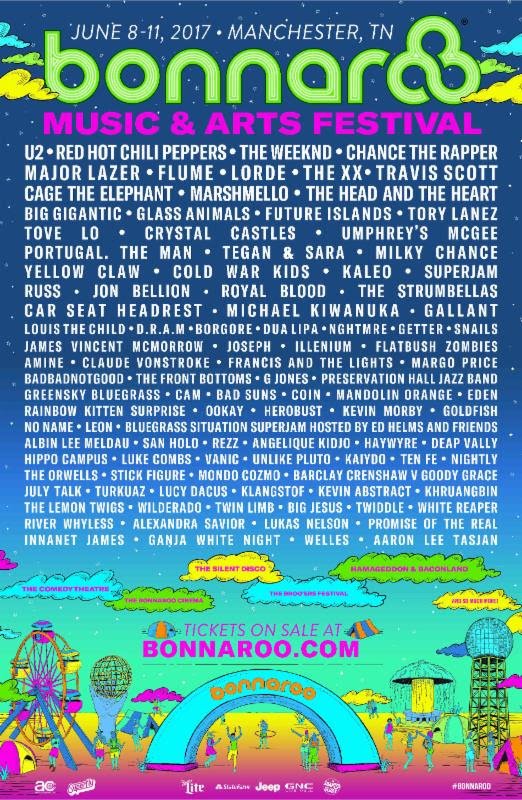
Bonnaroo Music & Arts Festival takes place June 8-11 in Manchester, Tennessee. Click here to buy tickets.
Real Player’s Music: A Conversation with Paul Hoffman of Greensky Bluegrass
Greensky Bluegrass first got together and started playing music in 2000, and the band has spent the better part of the years since on the stage playing dive bars, living rooms, festivals, or, more recently, sold-out crowds at well-loved venues like Red Rocks and Ryman Auditorium. The Kalamazoo, Michigan, band — which is made up of members Anders Beck on dobro, Michael Arlen Bont on banjo, Dave Bruzza on guitar, Mike Devol on upright bass, and Paul Hoffman on mandolin — has done its part to welcome new fans into the bluegrass fold, too, thanks to funky covers, relentless touring, and an approachable jam band vibe in and out of the studio that is evident on their latest full-length, Shouted, Written Down, and Quoted.
You started out playing in people's living rooms and at open mic nights. What aspects of your beginnings, the first couple of performances that you did, have you retained now that you're playing these huge venues? How did that shape the way you guys perform now?
That is a very interesting question. Congratulations. I think [what remains is] the spirit of what we do and playing for fun and making it fun. We kind of have, for better or worse, this motto that, if you want to be on the line, you've got to be over the line sometimes. There's a lack of fear of mistakes, or a lack of fixation on perfection. We were pretty bad in those early days, but we were just going for it, having fun. I think that spirit of us truly enjoying what we were doing and making music together translates really well with our crowd. The experience of our show and that whole aspect of it is really important to our music. It's one of the things that have kind of been there all long.
Tell me about Shouted, Written Down, and Quoted. What about that lyric stuck out to you for the title? What made you think that would sort of encapsulate the rest of what was on the record?
The whole verse is, "I know everything for all that I know, but there's always two sides to the way both of the stories go. Sometimes things are left unspoken, should be shouted, written down, and quoted." I think, for us, there's kind of a underlying meaning that “Shouted, Written Down, and Quoted” means things better left unspoken.
I don't know — we liked it. Album titles are tough. We threw around a lot of ideas. We debated this one because it's long. Shouted, Written Down, and Quoted … that's wordy. I dig it.
I think that lot of your fans are not necessarily bluegrass fans first: They're not finding your band because they're out looking for the hottest new bluegrass band. Some people may be finding out that they love bluegrass through Greensky. What about your music and the way that you interpret bluegrass do you think is drawing new people into the genre?
I suspect that you are entirely correct. I think its because we came [to bluegrass] that way, too. Most of us found bluegrass through the Grateful Dead, through Jerry Garcia.
In those early years of playing shows, we did all these bizarre covers. “When Doves Cry” was one of the first ones. That was the first off-the-wall thing we did. We'd go to these bars and do these gigs where I'd have to really sell the band to get us in there in the first place, to the manager or whoever is booking the bar, because they're like, "There's no drums? Do people like that?" Then we'd play "When Doves Cry" and it's like, "They know this."
It's the same story you hear about bands all the time playing covers to draw people into their sound. Not only does it draw them into us, it draws them into bluegrass. They’re like, "Maybe I like the banjo."
Maybe there's this preconceived notion before that bluegrass is hillbilly music that they would never be into. We're kind of a jam band and we improvise, so that's something that also drew us to the music — that bluegrass is a real player's music because there is so much soloing. It's like jazz almost. There are these standards. There's a form and a melody: You blow the head and then you improvise on the theme and then you blow the head and the tune's out. It's like what horn players do with be-bop. That attracted us all, as instrumentalists. It’s not like being in a rock band where the guitar player takes all the solos and the keyboard player does a little bit of solo flair, but it's really like the one guy's the lead guy and the rest are all the accompanists. We all do all the jobs. We all accompany each other. We all share the role of the drum kit. We all are soloists.
That brings me to another question I had because I know that you are one of the chief songwriters in the group. There's a big process from the time that you think of a song and when it's a finished song — or who knows if its ever really a finished song. Can you run me through the general process? How does a song go from being in your brain to being something that you're fleshing out with everybody to being something that you're either playing on stage or recording?
It varies from song to song. The typical process for Dave and me is that we write most of the framework of a song and the lyrics, and then the band is more involved in the arranging process. Sometimes we write the instrumental hooks together that go with the songs, which is often described from the melody of the lyrics. Sometimes it's different figuring out different parts, stuff like that, but the degree to which the song is finished can really vary.
There have been songs that I had written that were pretty much done when I brought them to the band and didn't need a lot. Then, there are others that needed parts. The textures and the rhythmic feels are where we can really experiment with our different influences and fusion. If it's a straight-ahead bluegrass tune, it's pretty easy to just figure out who does what and what goes where. When we start getting into different rhythmic textures, we talk about how a lot of our music has these soundscapes, and I think this album is a good example of that. There are moments on there that are spacey melody mood pieces more than a solo flair or something like that. It's not like, "That's so cool what he played." It's this texture that we all create together. For us, that's some of the most fun stuff we do.
One of my favorite songs on the latest albums is “More of Me.” Where did that song come from and what might it mean to you or what do you think it might mean to other people?
That's a good one for that soundscapey kind of thing that happens in the middle of that tune — just that bereft moment. I think it's very much resolved of what our lifestyles are like: touring and having other desires, maybe someone else, or maybe just other things in life that you don't have time to do because you're busy doing whatever you need to be doing. It’s about the idea of wishing that there was more of you to do all the other things. It's kind of creepy. [Laughs] I wrote it with the intention of being sort of romantic, wishing somehow that I could have more of me to leave you when I go. It comes off as a little creepy I've discovered, plus the melody and the general vibe of the tune is so dark. I joke around with Yoda, "More of me, keep you when I go, I will."
That's funny.
I think there's just some darkness in those lyrics that maybe I fell a little short on the romance. I think the concept is sort of romantic or lofty or idealistic or something like that.
Speaking of being in a couple of different places at once: Y’all recorded this in two different places, and I think I saw that this was the longest time that you've spent in the studio for any of your records. What effect do you think that had on the final product, and why did you choose to do it that way?
If you go back and read any of the bios of any of our records, we've said that every time, because that's what we do. That's how we increase our budget: We just take more time. Taking more time allows us to be a little bit more experimental. This time we came into the studio a little less prepared. We had played none of the tunes live. We had some really serious arranging and learning to do. We did it intentionally to let more of a creative process happen in the studio. With the earlier albums, spending less money and having a smaller budget, you want to be more prepared so you're not wasting your time, but also wasting your time can be really artistic.
We'd go down the rabbit hole of chasing some tone on an instrument or on a microphone for hours at times and maybe were aware the whole time that we weren't even going to use it. We just wanted to see if we could do it, challenge ourselves. "Let's try this tune like this." And then everyone being like, "I don't know if we're going to be able to do it or if it's going to be a good idea, but let's try it to see if we can accomplish it." Then, if we tried it and we didn't think it worked, we’d try harder to make it work, even though we might not use it. Having the opportunity to do that is, one, fun as hell. Two, it creates more of a creative process than just us going in there and playing the music.
We recorded in two places, which we've never done before, and we took a longer break than we've ever taken before between spots. When we recorded the last record, we took two days to just watch the Super Bowl and take a break, which was nice. This time, we had a couple of months off. As I mentioned, we were sort of composing the songs and figuring out what to do with them as we recorded them. We laid almost everything down in Nashville and then we had these really rough mixes of everything mostly done to sit on and reflect on and figure out what they needed and what they lacked and if they were working and how so and such.
You guys are on your own label and you've always been independent. Now that you've gotten to know the music industry a little bit better, do you think that's affected the band's trajectory at all? Is there anything that you particularly like about it or that has been an obstacle for you guys in doing that?
It's certainly presented some challenges and some unique development. Not to discredit record labels and what they do either, but I don't know if some gigantic budget to expose us to a wider audience would have made us like Mumford and Sons or something. I like that band, too, just so you know. But I get the concept that the record label now sort of stands for this thing that's like a million dollar loan: If you have enough money to invest, you can turn your money into a lot of money.
But we’ve self-funded our albums and stuff, and you know we're reaching a wider audience everyday and we're doing it one fan at a time. I have this theory that a lot of that stuff that the media of the music industry blows up can sometimes create hype for a band that the band's not ready for. If that had happened to us a couple of years ago, I don't know if we'd be as prepared as we are now. We keep taking a step up — steps up — into bigger rooms, and because those steps are somewhat gradual, we're learning a lot as we go. We're ready to carry the weight, so to speak.
In the lifespan of our band, a really awesome thing has been happening where bands like the Lumineers, the Avett Brothers, and the Head and the Heart, Mumford and Sons — these acoustic-esque bands that you guys cover a lot of and who write their own material — have come into the mainstream. A lot of that is really encouraging for us. There's this duality of successful music, and the very produced pop music and pop country that's succeeding is sort of creating this thirst for the opposite. I want something that sounds real, and it’s good to see a record just blow up because it’s real. I think that that's really cool, very encouraging.
Photo credit: J VanBuhler
7 Artists We’re Stoked to See at IBMA’s World of Bluegrass 2016
April may be the cruelest month, but September is by far the coolest one because we get to head to Raleigh, North Carolina, for one of our favorite events — IBMA's World of Bluegrass. Taking place September 27 – October 1, the event brings bluegrass fans from around the globe together for the pickin'- and grinnin'-est party this side of, well, anywhere. If you're heading to Raleigh and struggling to get your schedule together — we get it, there's a lot to choose from! — allow us to do some of the heavy lifting for you and check out seven of the acts we can't wait to see.
10 String Symphony
Nashville duo 10 String Symphony, also known as Christian Sedelmyer and Rachel Baiman, are no strangers to the stage, with Sedelmyer a member of Jerry Douglas's touring band and Baiman having fiddled alongside the likes of Kacey Musgraves. Their project together, though, brings those individual talents together for an acoustic, genre-defying sound that is truly like no other.
Missy Raines and the New Hip
Missy Raines has more Bass Player of the Year IBMAs than anyone out there, and there's no better way to find out why that is than to watch her kicking bass and taking names on stage. She and her band, the New Hip, fuse elements of jazz and Americana with her more traditional bluegrass leanings.
Bill and the Belles
Johnson City, Tennessee, quartet Bill and the Belles pay homage to their mountain upbringings with Tin Pan Alley covers and Appalachian-inspired arrangements. They're a joy to watch live, and we bet you can't make it through their set without smiling.
Hot Buttered Rum
With a name like Hot Buttered Rum, the music better be good, and, sure enough, it is. Just like the drink, a live set from Hot Buttered Rum goes down easy and leaves you with a smile on your face.
Molly Tuttle Band
Nashville multi-instrumentalist Molly Tuttle has a sonic range unlike many musicians out there, able to captivate listeners with tender vocals just as easily as she is with virtuosic guitar chops. This full band set should deliver, as the kids say, all the feelings.
Ricky Skaggs and Kentucky Thunder
If one of the greatest living mandolin players doesn't tickle your fancy, well, you just might be at the wrong festival. Whether you've never seen Skaggs live or this will be your 12th rumble with Kentucky Thunder, this is a set you won't want to miss.
Greensky Bluegrass
Just over a decade-and-a-half into their career, Greensky Bluegrass has never sounded better. Their forthcoming album, Shouted, Written Down and Quoted, is a sure sign that bluegrass is still alive and well.
MIXTAPE: The Capitol Theatre
Up in the farther most corner of Westchester County New York, right at the Connecticut border, sits a renovated 1920s playhouse that also happens to be one of the best music venues in the Northeast, if not the whole country. The Capitol Theatre first opened its doors on August 18, 1926. Over the 90 years since, it has seen quite a few changes … and a whole lot of history. In the 1970s, the Cap was an A-list rock club before a 1983 change in ownership flipped it back to being a traditional theatre. More shifts happened over subsequent decades until the Cap's most recent rebirth in 2012 with Peter Shapiro (Wetlands Preserve, Brooklyn Bowl) at the helm.
Here, Shapiro takes us through the club's musical history, song by song.
Grateful Dead — “Ripple”
Jerry Garcia said it best himself: “See, there's only two theaters, man, that are set up pretty groovy all around for music and for smooth stage changes, good lighting, and all that — the Fillmore and the Capitol Theatre. And those are the only two in the whole country."
With that level of praise, it’s no wonder that the Grateful Dead played the Cap 18 times in 1970-1971 alone. To this day, members of the Dead still play the Cap.
Janis Joplin — "Mercedes Benz"
Perhaps the Cap’s most famous true story of rock history is that, on August 8, 1970, Janis Joplin wrote "Mercedez Benz" at a bar in Port Chester called Vahsen’s. Later that night, she performed the song for the first time at the Cap in what turned out to be her last New York show and her third-to-last show ever.
Hot Tuna — "Keep Your Lamps Trimmed and Burning"
Hot Tuna has the distinction of being one of the few bands to play the Cap in all three major eras that it's hosted rock bands. Jorma Kaukonen and Jack Cassidy have played the Cap stage four times in the '70s, three times in 1989-1990, and twice in 2014-2015. They were back again this year.
Derek & the Dominoes — “I Looked Away”
The Eric Clapton-led supergroup didn’t tour much in support of their classic album Layla and Other Assorted Love Songs, but on December 4-5, 1970, the Cap was one of the lucky stages to have hosted this group. Duane Allman was not part of the band’s touring lineup but he also played the Cap with the Allman Brothers Band that same year.
Phish — “My Sweet One”
When the Cap was first reborn as a rock venue in the late '80s, many of the '90s future musical innovators were just beginning to make a name for themselves. Phish gained a huge New York following in the early '90s with seven shows at the Cap between 1990-1992 before moving on to bringing 80,000 people to their own festivals. While drawing from just about every musical influence under the sun, the Vermont foursome never shied from showing their love of bluegrass and Americana on songs like this one.
Little Feat — “Sailin’ Shoes”
During the Cap’s '90s revival, many bands that hadn’t had the chance to play the theatre in its prime were finally able to take the stage. In 1990 and 1995, rock heroes Little Feat were able to bring their unmistakable melting pot of musical influences to the Cap. Since reopening in 2012, they’ve been back three more times, and on September 9 of this year, we'll make that four.
Bob Dylan — “Times They Are A’ Changin'”
When the Cap was reborn in 2012, Bob Dylan had his first performance ever at the Cap in the newly renovated theater. What better song to celebrate an exciting new time in the Cap's history.
Willie Nelson — “Somebody Pick up my Pieces”
The country legend made his long-overdue debut at the Cap with two consecutive shows on September 18-19, 2013. Not many artists of his caliber can say that they’ve had several generations of fans in their audience at the Cap.
Wilco with Billy Bragg — “California Stars”
Jeff Tweedy and company were well aware of their musical roots when they recorded “Mermaid Avenue” with Billy Bragg. Using lyrics from Woody Guthrie they crafted music that sounded timeless yet relevant for the 21st century. In 2014, Wilco sold out three nights at the Cap to mark their 30th anniversary, even throwing in a nod to the Grateful Dead with a cover of "Ripple."
My Morning Jacket — “Get the Point”
While their eclectic sound can range from garage rock to funk and electronic music, My Morning Jacket always incorporates elements of their Kentucky roots. Despite having already headlined major festivals and arenas like Madison Square Garden, MMJ stunned the Cap with a three-night run of shows in 2012. To make these intimate shows even more special, each show had a unique set list with no songs repeated from previous nights.
The Avett Brothers — “Morning Song”
Of all the bands that have brought the sounds of roots music and Americana to new audiences in the last 10 years, few have generated as much excitement as the Avett Brothers. Their 2016 show at the Cap sold out within minutes, providing fans with a special and intimate night. The Cap loves to book bands that are known to play much larger venues as a way to give fans a once-in-a-lifetime experience.
Ryan Adams — “To Be Young Is To Be Sad (Is To Be High)
Few people have held the torch of consistently prolific songwriting in America as long as Ryan Adams. While his musical ventures have taken him as far as metal covers and Taylor Swift interpretations, Adams always returns to his folk-oriented roots. In his debut at the Capitol Theatre on July 24, 2016, Adams brought along bluegrass group the Infamous Stringdusters and singer/songwriter Nicki Bluhm. The Stringdusters and Bluhm added lush harmonies and acoustic bluegrass instrumentation to his songbook.
Greensky Bluegrass — “Burn Them”
Ninety years later, the future is most certainly looking bright with up-and-coming groups such as Greensky Bluegrass set to carry the torch for roots music on the Cap stage. The Michigan bluegrass group will be making their debut at the Cap on September 17, 2016.
Nashville's 3rd & Lindsley celebrates its 25th anniversary this year with a MIXTAPE of its own.
Photo credit: Scott Harris
CONVERSATIONS WITH… Greensky Bluegrass
Sure, that Halloween hangover may last a few days but we have a good cure for you: Michigan’s roving bluegrass-rock outfit Greensky Bluegrass will be in town for a rare appearance at The Mint this Friday, November 2 in a Sitch co-sponsored performance!
When these guys say they are one of the hardest working roots bands on the circuit, they ain’t foolin’ – after playing nearly two hundred shows a year for the last decade and change, this scruffy, down home gang has burnished and warm sound that appeals to lovers of classic alt-country, southern rock and picky bluegrass aficionados alike. With a growing national fanbase and subtly socially-conscious lyrics, they join local folksters (the also excellent) The Cerny Brothers for what should be a true treat of an evening.
The Sitch’s Z.N. Lupetin caught up with Paul Hoffman, mandolinist and co-composer in Greensky, for a few pre-show questions concerning firearms, tour life, the budget crisis, and who might be the fastest picker of them all…
Want to quickly touch on the title track of your last album “Handguns”. I especially was drawn to that melancholy chord change over ‘handguns make less mistakes without love’. Do you think that through roots music you can talk about social issues like gun ownership and the fragile human condition in a way that people will somehow understand and contemplate more deeply?
PAUL: The idea… ‘I’m gonna buy a handgun and make less mistakes’ just came to me one day and it seemed like this awesome image of responsibility and power. It evolved into ‘handguns make less mistakes without love’ when I wrote the song but the idea is about the same. In no way is a commentary on gun control or anything. (subsequently I think handguns are fun to shoot…) All kinds of music is great place to cover concepts such as this. I am a writer of music tho so my opinion is thus very biased. It’s a sad song. If we love we will make mistakes. Love drives us to make decisions that could otherwise be avoided.
You seem to like mixing in occasional electric or amplified instrumentation (and horns too) into your overall sound. Do you feel like it’s a slippery slope when the word bluegrass is right there in the name? Sometimes purists get huffy.
PAUL: There is this idea that the purist get huffy and I don’t think the same debate translates to any other genre outside of Bluegrass. It almost seems like a myth to me. Something people discuss more than they really care about. Like balancing the budget. ‘Real Bluegrass’ is just rhetoric. Truly we are not a ‘Real Bluegrass’ band all the time and it is in our name. Kinda tricky. It’s just our name though. We love bluegrass music. We all play bluegrass instruments but we are better described as a rock & roll band… probably.
Where is the most unexpected hotbed for acoustic music right now? You guys really see a lot of the road. Best off the beaten-path venue we don’t know about?
PAUL: Alaska? Hawaii? Tough question sorta. But seriously we played in the 49th and 50th state this year I was shocked how well we were received. I knew the shows would go well a and we would have a blast but I didn’t expect to be received so graciously. They thanked us as if we had traveled some awful journey to a place no one would go. In reality we were stoked to be there so it was really our pleasure. It’s a great thing when the feeling is mutual.
You have been to LA a few times already. Impressions? Are the crowds weird?
PAUL: LA crowds have been great. I remember being kinda of scared the first time. We’ve had a couple real high-energy shows in the city. It seems like bluegrass might not fit but really… it fits everywhere. Something I’ve learned about being a part of specific genre is that it takes some fish out of the pond. Then puts you in a smaller pond. People who are into bluegrass music (or whatever we are/aren’t) know how to seek it out. Goes for everywhere.
On your perfect tour – who would share the stage/bus with you?
PAUL: We just had the honor of bringing a Michigan colleague named Joshua Davis on tour with us for a few shows. He has been playing with a band named Steppin’ In It for years and has recently started focusing on a solo career. He has been a huge influence on my writing and he’s a great dude. It was an honor to have him on tour and to hear so many of our fans get excited.
Who has the fastest fingers in the band? Gotta lean towards Anders on that dobro.
PAUL: Hmm….I don’t think it’s Anders….
Can you describe how new songs come together for you guys? I like that in your bio that you stress ‘continuity’.
PAUL: Usually the writer brings the song to the group and all arrange it from a skeleton. Often I’ll have these vague concepts of things we can achieve with the feel of the song. Something we haven’t done before or something we do well but don’t have many applications for. I’m always hearing these textures and song ideas in other music that I want to achieve with our band. So I write a song and we try it.
What’s next? Rest for a bit after tour?
PAUL: We are taking quite a bit of time off this holiday season. In January we are going to start a new record. Probably be writing a lot of new material until then and working on putting together what we have. It’s been a great year but definitely looking forward to some time down at home.
